#but this robot and his media have owned me since 2014
Text

#big hero 6#bh6#baymax#disney#fanart#my art#i'll just be over here having feelings#yeah i'll give the mouse the side eye for a lot#but this robot and his media have owned me since 2014
33K notes
·
View notes
Text


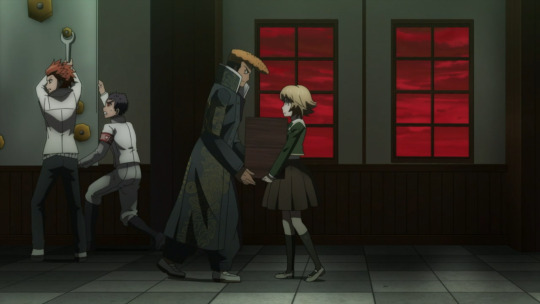

"If I don't do something, nothing's ever going to change."
-Ultimate Programmer Chihiro Fujisaki
TW: violence against students, bullying, murder, and corpse touching mentioned.
Contains SPOILERS for Case 2 of Danganronpa: Trigger Happy Havoc (2014).
I just started playing Danganronpa: Trigger Happy Havoc, the first Danganronpa game. Owned and developed by Spike (now Spike Chunsoft). Got an Anniversary Edition last year.
It is a violent point and click visual novel akin to the Capcom franchise Phoenix Wright games I dig with an emphasis on the investigations/trials which combine elements from dating sims and third-person shooters. Giving gifts unlocks skills for the protagonist and provides more data on the Report Card of the participant time was spent with. The third-person element occurs in the timed trial portion of the game.
Danganronpa: Happy Trigger Havoc is about high schoolers becoming trapped in a twisted life-or-death scenario orchestrated by the despair-seeking robot bear Monokuma: to escape they must slay each other and successfully avoid suspicion during the following trial. However, if the murderer isn't chosen during the trial everyone dies a.k.a. a game over happens. The player can, thankfully, retry from a checkpoint. Said murderer is given an "execution" cutscene that is distinctly tailored to them.
The game's dark premise is juxtaposed with lighter character based humor. Despite it being a horror game, blood is stylistically bright pink in color versus the traditional red. For me, this design choice let the murder scenes pop more and helped when investigating too.
However, the game's second case and subsequent trial of Chihiro Fujisaki's murder has really stuck with me. I saw Chihiro's gender as being ambiguous (I don't see clothing as gendered), but the second case's, ugh, twist is what the group referred to as a girl is in fact a boy. This was distastefully done via by checking Chihiro's corpse that lead to his genitals. Monokuma knew of the truth and still allowed the forced to be student detectives to discover this infomation in this inhumane manner.
...Case 2 additionally drops that a participant has Dissociative Identity Disorder. Notoriously depicted and done incorrectly in most media. Like in this...
Alll in all, why did Chihiro do what he did? Because he had an inferiority complex and saw himself as "weak". Others called him so. Thus Chihiro was bullied. Ultimately, to flee from this torment, he pretended to be a girl (from what's available concerning him in-game I don't think suggests the character was potentially trans) to avoid having to become stronger like was expected of his gender. And almost no one knew. Throughout the game, Chihiro spent most of his time alone and is clearly uncomfortable when called a girl: participants Aoi and Sakura both noted that when Fujisaki did hang out it was with the boys.
Furthermore, Chihiro was meek, shy, and prone to tears. Said I'm sorry a lot. Out of the cast I've interacted with, he's been the kindest. Chihiro mentions observing a mosquito literally sucking blood out of him but not killing it since the mosquito might have a family.
Alas, tragically, prior to being unexpectedly killed and overcoming his own insecurities, he went to the gym late at night to commence with his plan of being less "weak" in his and society's eyes. He told his genuine truth to the one he saw was a ideal man to help him. This person then took Chihiro's life out of jealousy stemming from their own falsified truth.
See, Monokuma was gonna divulge the secrets of everyone there the next day as an incentive for someone to commit murder and thus potentially depart from the horrific situation they were in. Previously, he showed everyone disturbing individualized videos the player isn't privy to (well, not all of them) resulting in the first murder taking place. The participants got to know what secret Monokuma was going to tell. During the trial, Chihiro's I mentioned earlier was his.
Something about Chihiro dealing with adversity as a boy to the point he mostly abandoned it yet kept this hidden from everyone left an impact the first trial remotely did not. Was relatable. Kinda inspiring even.
What he was doing would definitely be deemed probably taboo by Japanese society? More than likely. Hence why he having said truth told could have been extremely more life-altering.
Throughout my life, I endured bullying for trying to be what society considers how a "boy"/"man" should look or act. Thanks to an assigned designation from my birth that has never felt accurate. It took until my 30s to cease my own personal hellish masquerade I'd do. At almost 40, I still don't feel I'm quite myself, but I'm getting there.
I shall reach that desired point. Someday. My chosen family (some of my family too) recognizes and respects my truth: that means the world to me.
#chihiro fujisaki#danganronpa#gender identity#death mention#bullying mention#spike chunsoft#personal
1 note
·
View note
Text
What happened to Dirk in Homestuck^2?
Why am I doing this to myself.
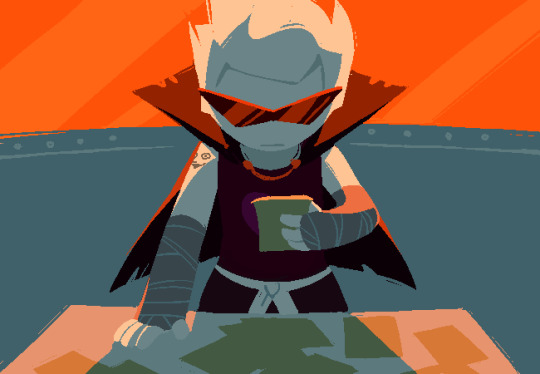
I memed a little yesterday when I was posting that article around social medias about Homestuck jokes, because once again we are in lockdown and I am therefore Stuck at Home. Canned laughter goes here. But there’s a topic related to the comic- or more specifically, its aborted sequel, Homestuck^2, that I’m interested in delving into a little bit. I’m going to avoid talking about spoilers as much as possible, but considering said comic takes place not only after the events of the massive sprawl that is Homestuck but also the more linear but still messy Epilogues, some amount of sus shit is inevitable.
Anyway. Much maligned is what the Epilogues and 2 did to everyone’s favourite decapitation target, Dirk Strider, and I have a theory as to why it happened this way.
To begin with, let’s summarise what and who Dirk is through the course of the comics. Fair warning from me, though, it’s been a while since I read through this.

Dirk Strider is a teenager who grew up in a post-apocalyptic future Earth, completely devoid of physical contact with other people and only really ever gets to talk to 3 other people, only one of whom is in anything remotely resembling a relatable situation. He struggles with self-identity, having created numerous robots including an artificial intelligence based on his own brain, aka Lil’ Hal. He’s somewhat of a control freak, and a bit of a cold aloof asshole, but means well, and is pretty gay. NBD. The kinda guy to set up a plan meticulously and thoroughly, not informing any of the moving parts even if said parts are his friends, and often involving some form of self-sacrifice.
Throughout the comic he further reckons with self-identity problems and his own self-loathing including entering a relationship with Jake which doesn’t go well and he eventually breaks off since he knows his overbearing and manipulative behaviour is Not Cool and Pretty Toxic but doesn’t know how to shut it off. Eventually he reaches the God Tier as a Prince of Heart, gaining the power to literally annihilate souls, which he never actually uses since he gets yeeted into deep (Paradox) space and then everything goes to shit. Except none of that happens because of the Retcon (aside from the God Tier bit) and we don’t actually see how that shit progressed in the canon timeline. I think. Dirk’s arc, as it were, doesn’t really come full circle- while he does assist in Dave’s character…growth? he really isn’t the focus of that conversation. This immediately precedes the action climax and there isn’t literally any dialogue after that so that’s what we’re left with.

I like Dirk in Homestuck a lot. It’s hard not to, considering the flashes heavily featuring him (Unite/Synchronise and Prince of Heart: Rise Up) are genuinely excellent, along with many of his music themes being absolute bangers. He gets to interact with Caliborn a lot, with a pretty great banter, there, and the whole splintered personality thing is a really interesting hook for a character. I think he’s my favourite of the Alpha kids, a controversial pick considering I know everyone loves Roxy so much. I think, I’m not as in tune with the fandom as that statement implies I am.
And then the Epilogues/Homestuck 2 came.
Now I read the Meat half of the epilogues first, but that’s more interesting, so we’ll tackle Candy first (this is going to get real confusing for those who haven’t read this comic, huh).
In Candy, Dirk almost immediately kills himself, citing the irrelevance of the timeline as cause, an act considered by whatever mechanism governs God Tier deaths to be Just because he hates himself (and also bc of things we’ll get into), so it actually sticks. This isn’t super relevant for the discussion, but that’s just kinda so unbelievably fucked up? Entirely? I’d imagine if you read Candy first you might get entirely turned off by this, which I’m sure a lot of people did.
Meat is where the, well, meat of post-canon Dirk is. You see, a concept very quickly introduced in the tail end of the original comic is the Ultimate Self, an idea where you somehow encompass every different timeline iteration or alternate version of yourself. This was pretty clearly tacked on to make it so characters whose arcs all happened in the retcon timeline could have their not getting an actual arc explained away, but it didn’t land then and it sure doesn’t land for me now. Anyway, in Meat, Dirk becomes his ultimate self, making him near-omniscient and able to control the fabric of the story himself- for much of this story, he is the narrator. And he uses this power to fuck with all his friends really distressingly without their knowledge (or consent), including breaking up a marriage, in order to further his own goals which largely appear to be just keep the story going so to not fade out of relevance. It’s a plot that makes no sense with his previous characterisation, but I guess now that he’s the Ultimate Self he’s a different person? But I liked old Dirk, and I don’t like New Dirk. He’s a villain now, but he made a much better anti-hero.

But this would be fine if he (or the epilogues, or Homestuck^2) were written well. But they aren’t. Dirk’s dialogue is long, painfully drawn out, with tangents that tend to amount to pure wank, misused literary references and pointless metaphors that go on and on, filling the screen with a bright orange screed that hurts to look at as much as it does to comprehend. It’s not fun. And we’ve seen Dirk communicate before, obviously, the story of Homestuck is built around chatlogs, but it wasn’t like this. He was sarcastic, dryly witty, blunt at times. Even when he was literally talking to a different version of himself it didn’t get that masturbatory.
I was so confused about what the hell happened to Dirk, because I had no idea what the hell someone writing this character was thinking when they turned him into this. And then, the 21st page of Homestuck^2 dropped.

And it all came together.
What Ultimate Dirk and Terezi are referring to is Pony Pals: Detective Pony, a children’s book about some girls who hang out with ponies and solve a mystery. It’s a real book, buy it for your 5-year-old.
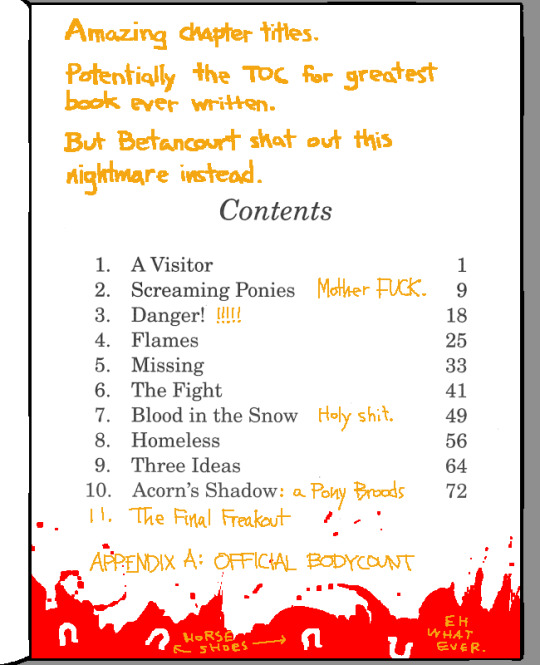
Except they’re not referring to that, they’re referring to the Homestuck Canon version of Detective Pony- a birthday gift from Dirk to Jane, heavily edited and to be much more obscene and eventually developing into it’s own story, stated to be “tough, emotionally draining, but cathartic in all the worst ways possible”.
Except the quote “Remember Longcat, Jane?” and references to philosophy, dead languages, and ancient earth culture aren’t referring to the three pages of the Dirk-edited Detective Pony we see in the actual comic itself. That quote doesn’t appear there.

That image is from Detective Pony, by Sonnetstuck- the 40,000 word fanfiction from 2014 that serves as a completed version of Jane’s copy of the book. An expansion of what we see in canon. And it’s a tough, emotionally draining read, but cathartic in all the worst ways possible.
It’s a very good fanfiction.
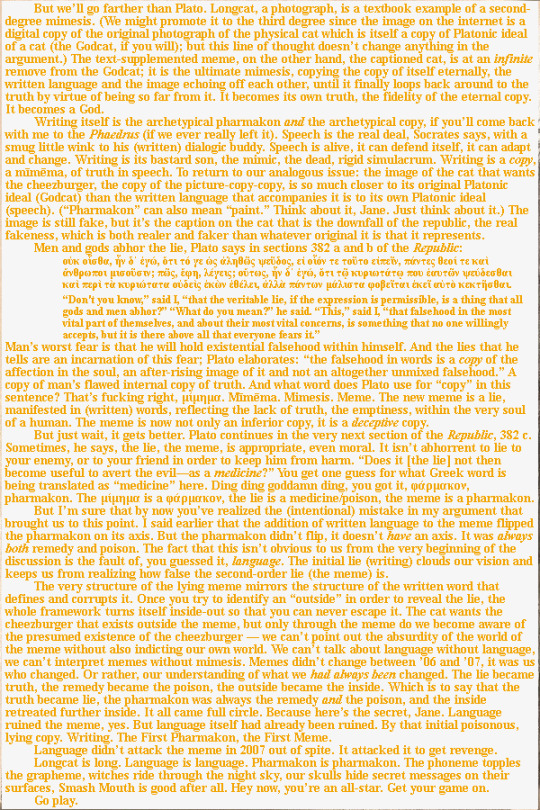
In the later bits of Detective Pony, we can start to see the origins of what would become Ultimate Dirk’s signature style of writing. Long blocks of rambling text, orange dripping down the page, references to philosophy and history and language that go on and on. And it probably does look familiar to those who read the Epilogues and ^2.
But there are a couple of key differences here. First of all, it’s just better written? The way these rambles circle back on themselves is so excellent, the absolute absurdity of this being written on top of a pony book for little girls, the humour (beyond some of the more immature stuff), it’s just a really well-written piece of fiction. Hell, you don’t even need to be familiar with the character of Dirk to enjoy it. It’s a harrowing piece, but it’s also self-aware- because it’s not supposed to be tough, draining, cathartic etc. just for Jane- it’s clearly that for Dirk himself.
The second part is, of course, that this is a fanfiction. It’s not canon, it’s not official, this is by someone who really likes Dirk for people who really like Dirk. It doesn’t matter in the grand scheme of things, so if you bounce off it (and I’m sure a lot did), then you don’t have to keep reading it, it’s fine, thanks for playing. As much as Homestuck^2 tried to doll itself up as “dubiously canon” it’s still the official continuation of the story, and that means if it’s as difficult to get into as Detective Pony, that’s going to be a problem for a lot of people.
The other part of it is that Detective Pony’s exploration of Dirk’s character is, well, in character. When the man himself steps in as a character in his own book, the explorations of what he is as an author, who he is as a person, make perfect sense for what we see of him at the start of the comic. He is that manipulative, blunt person, and he is aware of his faults. He’s the kind of person to hide a lamentation on his own failings inside an impenetrable maze of a story layered on top of a book about fucking ponies. Ultimate Dirk does not act like Dirk, outside of the “manipulator” angle, something that Dirk was aware of and trying to improve in the comic. But I guess people don’t have arcs, right?
It’s so interesting to see the seeds of Homestuck^2 laden within Detective Pony- because the meta angle that and the epilogues take is also represented in said fanfiction. While the nature of canon is a facet of the work, the idea of authors and narrators fighting for control of a story, different ideas in mind for the characters, one being more personally connected to them than the other, it’s all there. When I wrote about Fallout 4 in the past, I mentioned being worried that Bethesda took the wrong lessons from Skyrim- seeing something successful and trying to recapture that lightning in a bottle. I think Homestuck^2 is an extreme example of this- the writers of the comic saw Sonnetstuck’s masterwork and thought, yeah that’s great, we can do that. But they just can’t. And with the comic crashed and burning, the probably won’t ever get a chance to. Dirk is forever stuck as this amalgamation of himself that looks nothing like any individual version of him ever did.
At least we will still have Detective Pony, and many other excellent fanworks, for actually good Dirk content. I admittedly haven’t looked into much fanfic written during/post-epilogues, and I’m kind of afraid of what I’ll see- I can only hope the fanbase didn’t take the same wrong lessons as the official team did.
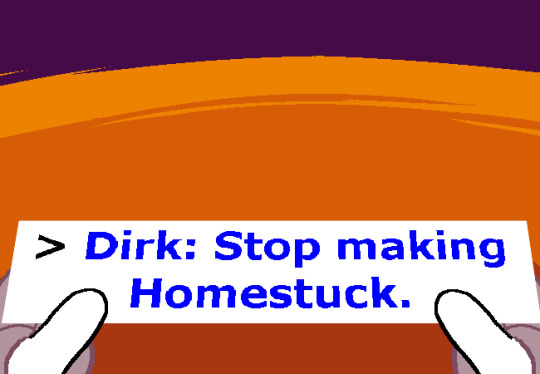
#ramble#honestly more of an essay#homestuck#homestuck 2#dirk strider#ultimate dirk#just ignore me accidentally posting this to the wrong account and having to reup it
32 notes
·
View notes
Text
Starship (Rewatch #4, 9/30/2020)
YouTube publish date: April 30, 2011
Number of views on date of rewatch: 4,171, 828
Original Performance Run: February 11-23, 2011 at the Hoover-Leppen Theatre in Chicago
Ticket price: $25
Director: Matt Lang
Music and Lyrics: Darren Criss
Book: Brian Holden, Matt Lang, Nick Lang, and Joe Walker
Cast album price and availability: $8.91 on Amazon and iTunes
Release date: April 29, 2011
Parody or original: original content, inspired by Starship Troopers, The Little Mermaid, and Alien
Main cast and characters:
Bug - Joey Richter
February - Denise Donovan
Commander Up - Joe Walker
Taz/Buggette - Lauren Lopez
Tootsie Noodles/Pincer - Dylan Saunders
Mega-Girl - Meredith Stepien
Junior - Brian Holden
Roach - Brant Cox
Specs - Julia Albain
Krayonder - Joe Moses
Musical numbers
Act I
“I Wanna Be” Characters: Bug, Roach, and Ensemble (playing inhabitants of the Bug World)
“Get Back Up” Characters: Taz, Up, and Starship Rangers
“Life” Characters: Bug
“Hideous Creatures” Characters: Starship Rangers and Bugs
“Kick It Up A Notch” Characters: Pincer, The Mosquitoes, and Bug
“Status Quo” Characters: Bug
Act II
“The Way I Do” Characters: Tootsie Noodles, Mega-Girl, February, and Bug
“Beauty” Characters: Roach and Bugs
“Kick It Up A Notch (Reprise)” Characters: Junior
“Beauty” Characters: Company
Notable Notes:
This production won the 2011 “Best New Work” award from BroadwayWorld’s Chicago theatre awards
Starship is Starkid’s first show that they produced independently from the University of Michigan! The show opened in Chicago, where the following few shows were produced before a majority of the most active members moved to Los Angeles prior to The Guy Who Didn’t Like Musicals, which opened in 2018
StarKid had their own short segment on MTV that highlighted certain aspects of the production such as Criss’ music and the puppetry (https://www.youtube.com/watch?v=UlnIXIGrjVg). At that point in time, Darren Criss was already a television favorite due to his role as Blaine Anderson on Glee, who joined the cast during its second season
The show’s cast album debuted at number one on Billboard’s Top Cast Albums within three days of its release and at the 134th spot during that week’s Billboard’s Top 200 chart (x)
The opening sequence features cameos from other StarKid members such as Chris Allen, Tyler Brunsman, Richard Campbell, Britney Coleman, Arielle Goldman, Devin Lytle, Lily Marks, Nicholas Joseph Strauss-Matathia, and Brian Rosenthal.The same sequence was narrated by actor Bob Joles (AKA Man Ray in Spongebob Squarepants)
***Fun Facts provided by Abby:
Nick and Dylan think the worst StarKid song is ‘Hideous Creatures’
During a rehearsal, Joey told Nick that he thought the choreography for ‘Beauty’ was boring. Then Nick asked him, “Do you want to choreograph the number?" and then walked out of the room.
There was a theoretical sequel to Starship in which Taz and Up arrest Spaceclaw but get injured by an explosion. Up ends up in the hospital because of his injuries, and while Taz waits for him to heal, she has flashbacks of when they first met and the missions they went on together (Taz’s quinceañera, etc.)
Lauren: I'd like to imagine that Taz has that same hairstyle just in a big quinceañera dress
Once during rehearsal, they were all in a bad mood during ‘Beauty’. Darren wanted to surprise the cast with a visit, so he burst into the theatre singing the song and was just met by silence
At LeakyCon 2014 on Orlando, StarKid were invited as guests and performed a staged reading of a one-act sequel to Starship called Starship: Requiem.
Official synopsis: The story follows the adventures of Mega-Girl the robot and her half-witted Starship Ranger husband. The newlyweds are sucked into a black hole of trouble when they go to visit Mega-Girl’s human-hating family, including her overbearing mother-unit, her jealous sister-unit and the return of her hunky ex-boyfriend-unit. (x)
Cultural Context: 2011
The production’s MTV segment aired a little over a week after Glee’s “Original Song” episode, which featured Kurt and Blaine’s long-awaited first kiss [rip Pavarotti]
Prince William and Kate Middleton get married
Harry Potter and the Deathly Hallows, Part 2 premieres on July 15th
Beyoncé announces her pregnancy during her performance at the MTV Video Music Awards
“Friday” by Rebecca Black gets released in March
In early May, President Obama announces that Osama bin Laden was killed by U.S. forces
New York becomes the sixth state to legalize same-sex marriage on June 24th
The 9/11 Memorial Museum opens to the public on the tenth anniversary of the attacks
Content Analysis:
During my time on social media, I have found that Starship is one of the StarKid shows that gets discussed the least. Up until the show’s debut in StarKid’s history, the only shows they’ve done were AVPM and AVPS, both major viral hits, and MAMD, which reached popularity partly because it was released after StarKid became known for AVPM. Coming off of their great and unexpected successes with these productions, one would think that there would be a bigger fandom for Starship. It’s their second show that is based on original content rather than being a parody, and the production quality is the strongest in their repertoire, considering the funds they gained from their album sales for MAMD and their growing merchandise sales for their Potter musical series.
Personally, it’s one of my favorite StarKid shows because of the production quality and because the performances are so strong. Joey Richter makes a perfect leading man, and seeing how his general abilities as a performer have grown since MAMD has been delightful. His vocal range got stronger and more pronounced and he has a very confident stage presence, especially since Starship was StarKid’s first production independent of the University of Michigan’s monetary assistance and performance space. Lauren Lopez and Dylan Saunders do such an incredible job at playing two completely different characters themselves within the same show. Saunders plays Tootsie Noodles, a lovable idiot with a heart of gold who falls in love with a robot of all things, while also playing Pincer, the villainous instigator of the plot. Lopez has a similar about-face in character portrayal. She plays Buggette, a bug who’s in a helpless one-sided romantic relationship with Bug, and then two seconds later Lopez transforms into Taz, a kickass Latina Starship Ranger with excellent comedic presence and the undisputed leader of the group before Up regains his confidence as commander.
Starship is very unique in that about half of the characters in the show are portrayed by puppets, which themselves are incredibly designed, but unlike other productions that use puppets, they do not detract from the actor’s performance of the character. StarKid did a very good job in ensuring that the puppets are not a gimmick, but rather a compliment, to their individual actor’s portrayal of the character. All actors who play puppet roles do such a great job of vocalizing their character that, despite the design of the puppet not having the ability to change facial features, make the puppets feel so alive that it’s almost like watching a live-action animated movie (the good kind we’ve yet to experience, not the Disney kind). If there is any one thing that Starship represents for the company as a whole, it’s that character creation and embodiment make up the heartblood of the performances. Aside from the vocal performances, the facial expressions and physicality of the performances add so much to the puppetry performances, even when the focus on the character isn’t their physical representation but their dialogue and place in the plot. Regardless of whether or not the recording is emphasizing the puppet itself during a scene, the actor controlling the puppet is using perfect facial expressions and has matching body language with the puppet, which not only helps the actor stay in character, but gives more life to the puppet itself.
While I am eternally grateful that StarKid to this day ensures that their musical productions are put on YouTube for free, there are two very clear downsides that make themselves especially present in the recording. One is that, unlike in live theatre where any audience member can choose who and what to look at onstage at any given time, the camera is the one dictating what each audience member can focus on. Generally speaking, that isn’t too much of a detriment as most of the shots StarKid uses tend to showcase the most important characters during each scene, which any audience member would do if they were to attend a production live, but because StarKid members are so adept at character performance, it really makes me wish that I can look more at the ensemble’s performances during group scenes, or secondary character’s reactions during smaller scenes in which their character may not be the main focus.
Another thing was the general editing style. Though it did not necessarily take away anything from the performance itself or make watching the recording any less enjoyable, there were some editing choices that I felt were too distracting for what the scene called for in the show. For example, when Crayonder mentions to Taz that he thinks that Commander Up has “gone soft” since the injury he sustained in the Robot War, twice does the camera pause on his face and a record scratch and ‘booooo’ track is heard overlaid onto the scene. I understand the comedic nature of that bit in retrospect, but for a viewer, regardless of whether or not they are watching the show for the first time, it’s very distracting and forcibly shifts the audience’s focus on the story and the characters to a one-off joke. For a first-time viewer, that editing choice especially does not have as much impact as it does for a recurring viewer, as at that point in the story, the audience is only just being introduced to the characters and has no personal connection to Up and his backstory, making the effect of the joke less successful. As well, throughout the recording, and during the first act in particular, the show has a lot of quick and experimental cuts in the frame that I feel don’t allow the audience to sit enough with the action and the performance happening onstage, instead making the audience pay more attention to quick facial gestures rather than allowing the audience to take in the performance of an individual actor or an entire scene as a whole. Overall, the editing just reminds me that I am watching this beautifully done live-performance through a screen rather than being there for the performance in person, and lessens the potential impact of the recording as a whole.
Regardless of the editing, Starship still has some of the best character performances and musical numbers in StarKid’s production history. One that really stood out for me during this rewatch was Denise Donovan’s portrayal of February. Her character gets introduced as a classic ditzy character who initially doesn’t have a lot of agency in the story, but through good writing and likable performance, grows into the most sympathetic and dynamic character in the show. Donovan’s performance makes February more human than the trope she represents, and plays off her character so well that her jokes make her more endearing than a throw-away character that’s used just for laughs and a love-interest. Starkid tends to do this with a lot of the trope-y roles that they write for their productions . The writing and the direction have a very unique way of taking seemingly predictable, one-dimensional characters and fleshing them out into entire human beings with backstories and arcs, making their comedic impact all the more enjoyable because the audience genuinely likes them.
#@TeamStarkid#for my independent study#starship#team starkid#starkid productions#starkid musicals#starkid#musical theatre#musicals#theatre#@stillunsteady#thank you!
6 notes
·
View notes
Audio
All the Lore I Know About Tekhartha Zenyatta
(with sources)
This probably isn’t everything the entire fandom knows- I’m sure people have worked out things that I haven’t -but this is everything I know as of June 2, 2019.
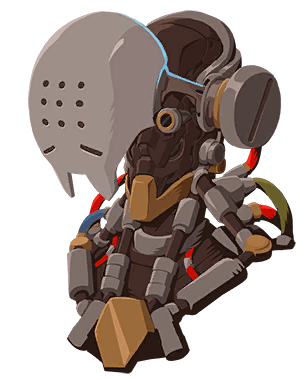
1. Zenyatta was built either after the Omnic Crisis or during its final days.
2051* - Omnic Crisis begins.
205x (2056 max)** - Omnic Crisis ends.
2056 - Zenyatta built.
2076*** - Overwatch Recall / Death of Mondatta.
*Metzen said the Omnic Crisis began 30 years ago, Chu said it began 25 years ago; Chu is the most recent source.
**Orisa’s hero profile indicates that one of her predecessor models was decommissioned 20 years ago "after the war”, putting a maximum Crisis end date of 2056.
***Metzen said in 2014 that the game takes place “60 years” in the future, but for my sanity I am advancing that date 2 years to match the release year of the game.
Zenyatta is 15 years younger than his student, Genji. Zenyatta’s “Shell” spray, seen above, was part of an Archives 2017 spray set that showed heroes as young children.
+ playoverwatch.com, Zenyatta Hero Profile
+ playoverwatch.com, Orisa Hero Profile
+ Chris Metzen, Overwatch Unveiled Panel, Blizzcon 2014
+ Michael Chu, Blizzard Forums, 2016/8/17
2. Zenyatta, along with the rest of the Shambali, were already outcasts when they had their spiritual awakening.
You can figure this one out through a careful reading of Zenyatta’s hero profile:
Years ago, following the Omnic Crisis, a group of outcast omnic robots experienced what they described as a spiritual awakening. They abandoned their preprogrammed lives to establish a communal monastery deep in the Himalayas.
I’ve noticed a lot of people get this confused, and think Zenyatta was outcast from the Shambali order, but that is not the case. The Shambali were collectively unwanted before their enlightenment. Cultist Zenyatta describes his pre-monastery status as “No one of note. Just one of thousands like me.”
What does “preprogrammed” mean? There’s a good example in the Retribution mission. At the end of the mission, players encounter a host omnic at an outdoor restaurant. Regardless of the disastrous situation in Venice at the time, the host has a few dialogues about dinner reservations, menu specials, etc. The host makes discomforted noises if players attack them, but never attempts to defend themselves. They sometimes even ask “would you like to know the specials?” as they are dying. This is not because the host is unintelligent, but because they have a program in place defining their actions. The host has yet to experience a moment of clarity that allows them to move beyond their original programming.
Understanding one’s own programming does not automatically result in a Shambali either. Theirs was a spiritually-oriented path, but an omnic realizing how they are being taken advantage of can also lead to unrest, or movements like Null Sector. Overcoming original programming (with various results) is a constant theme for all omnic heroes, from Bastion to Orisa.
--[SPECULATION: Despite being built as civilian models with similar modes of operation to the waiters, clerks, and laborers we have seen in various Overwatch media, it is possible that most of the Shambali were unwanted when they finally emerged due to post-war conflict between humans and omnics. They had programming telling them to accomplish a particular task, but they could never act on it. This could explain why they appear to have had a collective epiphany about their nature and moved as a group to establish their monastery.]
--[QUESTION: Omnica Corporation and the omniums were already shut down for fraudulent production claims before the Crisis started. Who was continuing to make new omnics even during the war, and by what method? Was Zenyatta built in an omnium, or by a more traditional method like an assembly line, or hand-built like Orisa?
We also know that omnics are continuing to be made today, such as the “child” companion omnic seen on the Blizzardworld ride poster, or the OR15s.]
--[QUESTION: Where was Zenyatta built? His hero profile only indicates that the Shambali established their monastery in the Himalayas. It gives no indication on how far they traveled to reach that location.]
+ playoverwatch.com, Zenyatta Hero Profile
+ Junkenstein’s Revenge 2018, Cultist Interactions
+ Glen Brogan, Overlord Transport Poster, 2018/1/23
3. For Zenyatta, the term “brother/sister” has multiple possible contexts.

--[SPECULATION: Zenyatta uses “brother/sister” in the traditional religious context when referring to other Shambali. But from the previous point in this list we know that the Shambali were already together in a group when they had their spiritual awakening, so it’s possible that they were all built in the same place at around the same time. This would also be a form of siblinghood.
Zenyatta and the other Shambali may consider all omnics as part of their “family”/in a state of camaraderie with them, hence why Zenyatta refers to Orisa as his sister despite her not being a monk. Zenyatta only ever refers to Bastion as “my friend”, but Bastion has no gender so it may simply be the easiest non-gendered replacement for the endearment.]
+ Zenyatta, Voicelines
4. The Shambali established their sanctum in the ruins of an ancient, preexisting monastery.
+ Overwatch Visual Sourcebook, Environments: Nepal
5. Zenyatta’s name...is Zenyatta. “Tekhartha” is a title. Mondatta also had this title.
--[QUESTION: Is the “Tekhartha” title something every Shambali takes upon joining the order, or is it a rank indicative of leadership? The term is a portmanteau of “technology” and “Siddhartha”, the name of the child who would become Buddha.]
+ Michael Chu, Blizzard Forums, 2018/5/25
6. Mondatta was Zenyatta’s master/mentor...maybe.*
*This might seem like a gimme considering Mondatta is the spiritual leader of the entire Shambali religion, but Zenyatta only ever refers to him as his brother in the main game. It’s in his Cultist incarnation that he describes himself as “following in my Master’s footsteps, searching for enlightenment”.
Wisp (Tracer) also refers to Mondatta as Cultist’s master. Mondatta certainly carries himself like someone older than Zenyatta- not that age confers wisdom, but it’s part of Mondatta’s professorial aesthetic. Zenyatta’s profile unhelpfully describes him as “enigmatic”, but this just brings us back to the question of whether or not the Shambali were all built at the same time and from the same facility. So the crux of this point is whether or not you think Cultist’s story is a reference to real-world history, or if it is AU-only.
The Halloween stories have their own little worlds with their own little plot arcs (at least in my head ;)). Obviously there are some (intentional) similarities to the real world, but it’s not intended to be one to one. [Michael Chu]
+ playoverwatch.com, Zenyatta Hero Profile
+ Junkenstein’s Revenge 2018, Cultist Interactions
+ Michael Chu, Twitter Comments, 2018/10/9
7. Zenyatta’s metal orbs were hand-carved at the Shambali monastery and are used to channel omnic energy.
+ Overwatch Visual Sourcebook, Zenyatta
8. Zenyatta’s abilities as shown in the game exist for “gameplay reasons”, but he is canonically able to heal others by an unknown method.

The Mercy interaction is what explicitly confirms Zenyatta’s healing abilities, but I threw in the Moira one because it is such a wonderful display of character. Moira does not immediately see a scientific explanation for Zenyatta’s abilities, and Zenyatta reframes the question to propose that truly understanding how he functions is the same as understanding how he exists, which is not a physical phenomenon a scientist could observe and measure to resolve with a hypothesis.
Zenyatta is hardly an enemy of the scientific method. He’s just not sure how it can answer the spiritual questions he’s interested in. Upon visiting Oasis he will actually wonder aloud “Can science alone unlock the path to enlightenment?”
Check the Bonus section below for a Cultist interaction that also describes Zenyatta’s abilities as non-magical, but also non-technological.
--[SPECULATION: Zenyatta’s levitation is also a non-technological function. Everything that floats in Overwatch leaves a trace, such as jet trails or blue hover-rings. Everything except Zenyatta. The dude just cruises around on pure enlightenment, which is a trope in both Hinduism and Buddhism.
Zenyatta was originally given the ability to float to distinguish him from other heroes (see the Development section below), but as a character there is no reason for him to artificially give himself the ability to float. Remember that Zenyatta does not seek recognition for his spiritual status. It’s more like a side effect.]
+ Zenyatta and Mercy Interaction added in October 2018
+ Zenyatta and Moira Interaction added in October 2018
+ Junkenstein’s Revenge 2018, Cultist Interactions
+ Jeff Kaplan, “Blizzard’s Jeff Kaplan Answers Questions from Twitter” by Wired/Youtube [07:39], 2017/5/17
9. Zenyatta’s disagreement with the direction of the Shambali religion was not his primary reason for leaving the monastery. He left because he wanted to learn by traveling the world. He remained on good terms with Mondatta and the rest of the Shambali after his departure.

--[SPECULATION: After Mondatta’s death, Zenyatta’s relationship with the remaining Shambali may have become more strained due to his long-standing opposition to Mondatta’s approach and his long absence from the monastery. This would explain why despite his good terms with the other monks, he wonders if he would be welcome in Nepal.]
--[SPECULATION: Genji and Zenyatta are shown spending Christmas in Nepal the year of the Recall. I hesitate even putting this as speculation honestly. I think Zenyatta did finally reconnect with his brothers and sisters the Christmas after Mondatta died, perhaps following Genji’s lead since the monastery is Genji’s home at this point. However since I can only find architectural similarities and not an exact location that matches the comic I guess the devs reserve the right to pop back in 2 years from now and say “actually they were in Singapore.” (╯°□°)╯︵ ┻━┻]
+ Jeff Kaplan, Summarized comments via Manolo Rosenberg/Twitter.com, 2017/11/9
+ Nepal Map, Zenyatta Voicelines
+ Nepal Map, Genji Voicelines
+ Comic: Reflections, 2016/12/20
10. Zenyatta and the other Shambali monks use cooking as a tool to encourage empathy between humans and omnics, even if they themselves cannot eat.
+ Overwatch: The Official Cookbook, Til Ko Laddu Sesame Sweets Recipe, ETA 2019/10/1
11. Zenyatta’s belt has the word “zen” written in Japanese on the tassel.
In earlier concept art, the word “zen” was on Zenyatta’s orbs instead, and it was written in Chinese. The word changed languages and locations later in development. “Zen” itself originates from Zen Buddhism, a Buddhist school from China that emphasizes the act of learning over the doctrine of what is learned, making it a very good fit for Zenyatta, his conflict with the Shambali, and his method of teaching through interaction rather than reciting dogma.


--[SPECULATION: Genji gave the belt to him to signify their bond, or they traveled in Japan together at some point and acquired it then.]
--[SPECULATION: The tattered scrap of cream cloth under Zenyatta’s belt is also emblematic of a bond- his life with the Shambali.]
+ Zenyatta Reference Kit
+ Overwatch Visual Sourcebook, Zenyatta
Zenyatta Development Notes
If you have ever watched the “Making A Hero” panels from Blizzcon or gone through The Art of Overwatch concept book, you know that heroes tend to arise from one of three domains: 1) Narrative need - for example, Ana had a backstory long before the team figured out how to integrate her into the game, 2) Gameplay need - ex. Junkrat was created because the devs wanted an indirect damage dealer, 3) Conceptual art inspiration - Zenyatta and Zarya both originated from drawings organized around a particular theme, “cyber monk” and “physically strong female character” in their respective cases.

This led to Zenyatta’s initial development as a martial artist, with a powerful physicality. Despite a lot of iterations, the team decided his intimidating presence was too much like other heroes in the game, and they began turning him into more of an “enlightened sage” trope, skinny with the ability to levitate to further set him apart from other heroes. His original concept with many arms lives on in his Transcendence ultimate.

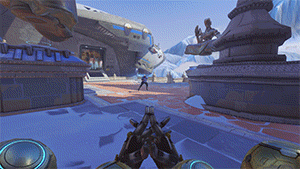
Originally his orbs were meant to be physically fired at enemies, but facing technical challenges such as figuring out how he would reload, the devs changed the orbs so that they would unlock and fire energy at enemies instead. This approach also lent itself to abilities like the Orbs of Harmony and Discord.
youtube
Above: Video of Baoding balls, metal balls with a distinctive chiming sound used in China for hand exercise
In terms of philosophical and religious concepts, Zenyatta is kinda all over the Eastern cultural map. He’s got two sprays referencing Korean martial arts and games, he’s got two skins referencing Chinese characters, another pair referencing the Egyptian sun god, and another pair for Arabian jinn. According to The Art of Overwatch his legendaries at launch were themed around “enlightened mythological figures”, which the devs felt suited his sage archetype.

Above: Photo of a building in Pashupatinath, a Hindu temple complex in Kathmandu, Nepal
The Shambali religion takes mostly from Buddhism, though the village below the Shambali monastery invokes Newa architecture. The Newari are a group of indigenous Nepali people who mostly practice Hinduism. It’s not unheard of for philosophies and religions to mix and expand on each other, and a multicultural background may be appropriate for Zenyatta who is a wanderer searching for knowledge, but it does make tracking down particular influences on his character a little boggling at times.
I realize I haven’t covered the mudras (ritual hand gestures) Zenyatta uses yet, but considering the length of this post and how image-intensive that would be, I will in fact let you google those on your own, or perhaps I will make a separate post about it at some point.
Bonus Section: The Cultist Conundrum

As part of Junkenstein’s Revenge 2018, Zenyatta’s Cultist character got 10+ new interactions, many of which don’t seem to reference his Cultist nature very closely. There are several that illuminate Cultist’s relationship with the Swordsman (Genji), some that indicate the Cultist is seeking to help others through their troubles just like Zenyatta, and one interaction that takes on a more ominous tone. To be honest it’s a wonderful exploration of a hero, but since it’s trapped in the Junkenstein’s Revenge AU, we have no way of knowing what’s ultimately true about it for the less cephalopodian version of Zenyatta.
All that said, I think these interactions are just really really good, so I’m going to include them in this post.
Shieldmaiden: Your master is a mysterious-looking fellow.
Swordsman: I have learned much from him, but little about him.
Genji wants the lore bombs too btw.
Shieldmaiden: What do you make of the monk?
Viking: I do not trust him and his strange gods.
Listening back to the audio of this, the Viking is very specifically saying gods, plural. Polytheism is a big part of Hinduism and to a lesser extent a part of Buddhism, but this is more likely a reference to Cultist’s eldritch origins, the “Great Old Ones” of H.P. Lovecraft’s Cthulhu mythos. It’s also an echo of Torbjörn‘s opinion of the Shambali religion in the main game (“It's like a culmination of a thousand of my worst nightmares!”).
Shieldmaiden: Why did you come here?
Cultist: I am following in my Master’s footsteps, searching for enlightenment, though my path has not always been a straight one.
I discussed this earlier as being one of the references to Mondatta as Zenyatta’s mentor. We know he is referring to Mondatta due to a separate conversation with Wisp:
Wisp: How can you trust the Countess after she slew your master?
Cultist: Did I say I trusted her?
I recommend hopping on Youtube and giving this interaction a listen if you have never heard it before. As we know from this and other main game interactions, Tracer is extremely pissed about what happened to Mondatta, and views the outcome as her own fault. In this case she actually takes that anger out on Cultist, enraged that he could remain so calm with Countess (Widowmaker) herself at his side. For his part, Cultist is quick to differentiate cooperation from trust. Perhaps the most unfortunate part about the additions to Junkenstein’s Revenge 2018 is that the Countess has no interactions with anyone, so there is no elaboration on Cultist’s thoughts about her.
Shieldmaiden: Is it magic that you do?
Cultist: It is not magic, but the power of the spirit that I channel.
Whyisn’tthisjustanormalBrigitteandZenyattainteractionFROWNYFACE. This interaction tells us that spiritual energy is not magic by Overwatch standards. That’s a close alignment with Eastern cultural views, and a clarification from Western ones where anything supernatural is by its nature a form of magic (very fitting that Brigitte is the one asking the question).
To maybe explain this a little better, let’s look at a popular TV show like Dragon Ball Z. Despite Goku having supernatural powers, no one refers to him as a witch or wizard. He instead is considered a manipulator of life energy. Did you feel bad reading this? I felt bad writing it. But I think it’s a good way to differentiate the concepts, especially for anyone who is really hung up on the “Overwatch has no magic!” preconception and then has to reconcile characters like the Shimadas or Zenyatta.
The primary issue with this interaction is its context: Cultist is said to “answer to a foreboding presence- a force beyond mortal understanding”. This is another Lovecraft reference, but it creates a background that doesn’t really match with Cultist’s spirit-oriented response. Maybe he means “the Spirit” with a capital S, but I have a suspicion that this is a regular Zenyatta answer sneaking into the Junkenstein AU.
Shieldmaiden: How is it you have barely broken a sweat?
Cultist: It must be my many years of training, simple diet, and careful way of life.
BLESS YOU BRIGITTE.
Reminder that the guy she’s asking this question of looks like this:
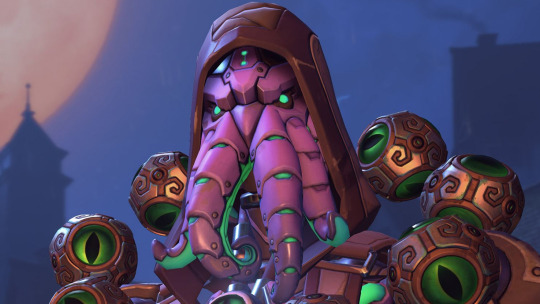
Swordsman: Watch yourself Master! I cannot mind your back at all times.
Cultist: Do you think me so helpless?
Swordsman: Battle is not your way.
I like this interaction more for what it tells us about Genji. He’s protective of Zenyatta, not so much because he views Zenyatta as weak, but because he knows Zenyatta would prefer not to fight at all. He wants Zenyatta to live his ideal life rather than the one reality necessitates. This is another interaction that doesn’t quite mesh with the general concept of the Cultist- an outcast who would do anything for forbidden knowledge. I suppose it’s possible that despite his frightening appearance and the broken manacles dangling off his limbs, he is actually benevolent. This concept is echoed in another of the Swordsman’s interactions with him:
Swordsman: It is strange to see you taking part in the battle, Master.
Cultist: There are times even I cannot stand by.
I guess Genji already forgot about that robo-spider chilling in a cave that they both decided to beat up for some reason.
Cultist: A pause in the battle. An opportunity to recenter our minds.
Swordsman: I am centered.
This interaction starts showing us the other side of the coin- that Zenyatta is trying to advise Genji as best he can on how to proceed through the fight without letting his emotions take control. Genji reacts uh...emotionally.
Cultist: Take care that you do not spend yourself before the battle is done.
Swordsman: I am only just getting started!
Genji, in both these cases, is showing himself to be a little prideful.
Van Helsing: You some sorta...holy man?
Cultist: Simply a traveler, in search of purpose and meaning.
Van Helsing: Aren’t we all.
This goes back to that Zen Buddhism idea that what is important is the act of learning or the journey to an answer, and not the answer itself or what the act of learning causes you to become. In this case, as in the main Overwatch universe, Zenyatta is probably aware that “holy man” is a title conferring a certain deference upon him, and he has no need for that- in fact it may be detrimental. Mondatta’s adoring flocks are never something he has desired.
Cultist: Some believe that the full moon is a good omen.
Van Helsing: Maybe...if you’re a werewolf.
Zenyatta, in his Cultist role or otherwise, happily soaks up surrounding cultures. Here he’s bouncing an idea off McCree that he hasn’t embraced himself (”some believe”), but he picked it up somewhere and upon noticing his environment, seeks to learn more from whoever is available to answer. When this interaction plays, it’s always the first interaction of the game- so Cultist is trying to instill confidence for the fight ahead too. McCree isn’t having any of it though.
Viking: Who were you before you entered the monastery?
Cultist: No one of note. Just one of thousands like me. But one moment of clarity changed everything.
New lore: Zenyatta worked at McDonalds and then one day he saw god and god asked for some chicken mcnuggies.
Viking: I find your religion unnerving, monk.
Cultist: My beliefs are simply in the fundamental ways of life and nature, nothing more.
You coming out here telling me the Cultist and not just regular old Zenyatta is the one saying this, Jeff? (To be fair, I never personally witnessed the Cultist’s response to the Viking’s comment playing in-game- it’s something that seemingly only exists in datamined content.)
Viking: Single-mindedness of Dr. Junkenstein’s creations reminds me of your own!
Cultist: You wound me.
Viking: Is that even possible?
Cultist confirmed to have inherited regular Zenyatta’s sass. I would also like to use this space to point out that Cultist has more interactions with Shieldmaiden, Swordsman, Viking, and Wisp than Zenyatta does with Brigitte, Genji, Torbjörn , and Tracer. If you want the Zenyatta juice, you really have to look at Cultist closely.

Cultist: You blame yourself for the dragon’s reign of terror, but it is not your fault.
Viking: You weren’t there, monk. You don’t know about my failure.
Squid Zenyatta is still trying to help people out. We learn through some of the Viking’s other interactions that his home village was destroyed by a dragon. This might be interesting as a clue to Torbjörn‘s real-life history, but the dragons of Junkenstein’s Revenge don’t necessarily equate to the Omnic Crisis.
Cultist: Rarely has my path crossed a warrior as cheerful as you.
Viking: When you’ve seen as much as I have, either you laugh, or you go mad.
Note that any interaction between Cultist and Viking that the Viking starts is very antagonistic/accusatory, but he actually relaxes when Cultist does not reply in turn. There’s a paternalistic vibe.
Wisp: I don’t think I’ve ever seen you sleep!
Cultist: Meditation is all I require to sustain myself.
Fun fact!: a small number of Buddhist monks practiced extreme forms of asceticism where they reduced food and water intake to a stopping point, had their apprentices bury them alive in a box filled with charcoal or salt, and meditated until their deaths. This act of self-mummification was thought to allow the monk to remain in eternal spiritual contemplation.
Wisp: Would you tell me more about your religion?
Cultist: Our purpose is to show everyone that in the Iris, we are all one people.
Another interaction that honestly would not seem out of place in the normal game, except that Tracer presumably knows about or even practices the Shambali religion already, given her attendance at Mondatta’s speech. At the very least she empathizes with the Shambali’s goals.
Cultist: When I gazed into the Iris, I found a great nothingness. It changed me. You must have experienced the same.
Wisp: That is not what I saw!
At last, a properly creepy Cultist interaction! So through some other conversations we learn that Wisp was a traveler torn from her body by a magical catastrophe, and she now inhabits the world as a ghostly wraith. Cultist interprets this to mean she passed through the Iris, and that the nothingness there is responsible for her transformation (just as it was for his? I wonder what he looked like before).
The “nothingness” he talks about may actually be less sinister than it sounds. There is the aspect that comes from Cthulhu stories, the idea of death as an infinite void, and the madness that may result from gazing too long into an abyss. Yes, that is terrifying.
But there is a nearby word, “emptiness”, that has a great deal of meaning in the various schools of Buddhism. The basic idea is that no being or thing in the universe possesses an intrinsic nature, that nothing stands alone but rather is woven together with all other things (does this sound familiar yet?). The Sanskrit word for this concept is sunyata.
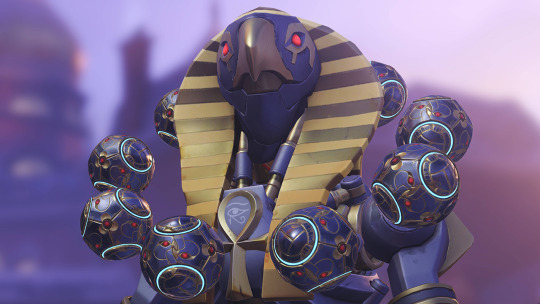
So yeah, maybe Cultist isn’t so bad. Maybe he’s just a little misunderstood.
676 notes
·
View notes
Text
10 female characters tag
@timothydraike tagged me to post 10 favourite female characters from 10 different fandoms and then tag 10 people, but honestly this list isn't gonna be too different from my 10 fave characters list cause most of them are women anyway 😂 😂 but here you go:
Nausicäa // Nausicäa of the Valley of the Wind, Studio Ghibli
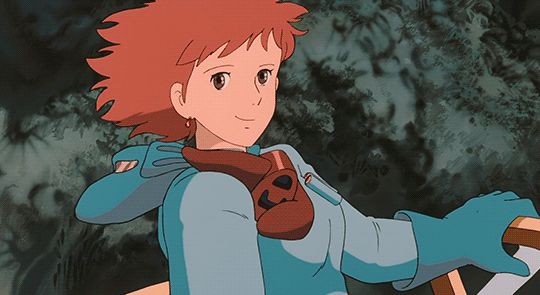
I didn't explain it last time, but I feel like she is the prototype for all the Ghibli girl heroines, free and autonomous, except she's a young woman who knows exactly what she believes in and wants to do. She's a warrior princess who believes in peace and kindness rather than war; she listens to mother nature and tends to her garden as deftly as she handles her glider jet; she's a born leader who puts her subjects' wellbeing before her own immediate safety. This gif here shows the moment she took of her own gas mask to boost morale while they're crashing into a toxic wasteland. I don't think I've seen many representations of female leadership as compelling and utterly human as hers was before or after this film debuted in popular media.
Harley Quinn // DCU

She's a bundle of contradictions but it's in that I find a female antivillain/antihero that feels real. Her stocky build and bit of chub in the tummy area? Real. Her slobbish habits and love for nasty junk food? Real. Her all encompassing empathy for animal welfare? Real. Disregarding the artists that draw her with too big boobs, she's so ordinary in her appearance and habits that it actually feels like she's the kind of girl that media often overlooks. She's like the manic pixie dream girl but rounded out with relatable human traits.
Tsunemori Akane // Psycho-Pass

I related to her when I was 20 (exactly her age at the start of the series) because I was at a crossroads in life, just as she was. I was searching for my calling, just as she was trying to understand her purpose and place in society. And at that point in my life, I could appreciate the duality between abiding by the system (legal reformation) and questioning the system (dipping into revolutionary ideas). I can't see myself relating to a cop anymore now obviously, but she's a rather unique figure that I still think about.
Ava // Ex Machina (2014), filmblr

She brings out all my post-humanist sympathies. And I think she captures a sort of queer android and Other perspective, one that the male characters feel threatened by, that women can understand well.
Maeve Millay // Westworld
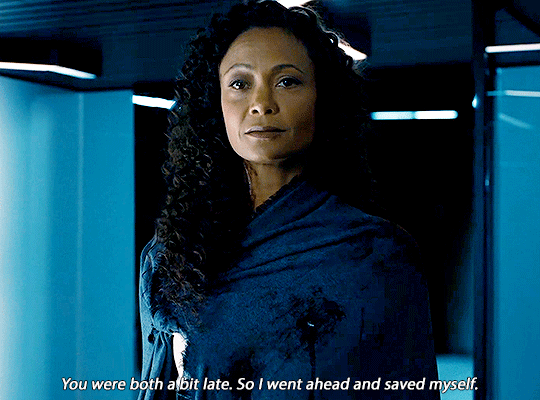
She's my murder mom. Something something about "I've died a thousand times, I'm not afraid of death" (I'm paraphrasing majorly), she's so badass. The fact that she was one of the first androids to awaken and actually challenge the humans, there's so much power in her taking her trauma in stride and moving forward nonetheless. And I think you can see a recurring theme here lolol
Lois Lane (Gotham City Garage) // DCU Elseworlds
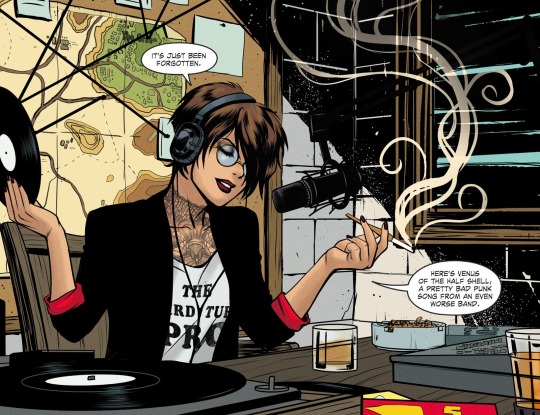
Perhaps this is just preserving a core attribute of her main continuity counterpart, but I absolutely adore the spirit she embodies of journalists who stay defiantly committed to truth and justice in the face of insurmountable odds. Fighting against a fascist terror regime - which hits very close to home - and keeping the broadcast going even out in the wasteland. In this last aspect she carries similarities to Dr. Death Defying's character from Gerard Way's Killjoys series, except she's a woman and she was actually fleshed out as a character with a heart and soul and a lot of gravitas. How can you not love her?
(and I forgot this was supposed to be 10 characters from 10 different fandoms until I finished this list but let's say her being an Elseworlds character counts as a different fandom 🤡🤡)
Ripley // Alien (even tho Sigourney Weaver's personal politics is a bit yikes)
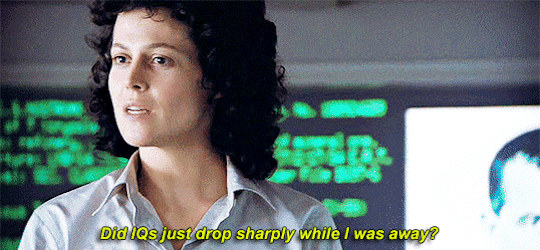
The proto-final girl and original warrior mother in sci-fi wrapped into one. (Ok, the crown for modern scifi warrior mother might have to go to Sarah Connor actually, but that's also another Cameron invention so they can share that title.) Even tho I can't relate to most of her character arc, I'm still very impressed by her character. They even touch on her PTSD a little which is unheard of in the contemporary movies at the time.
Honorary mention: Sarah Connor // Terminator
Marceline the Vampire Queen // Adventure Time
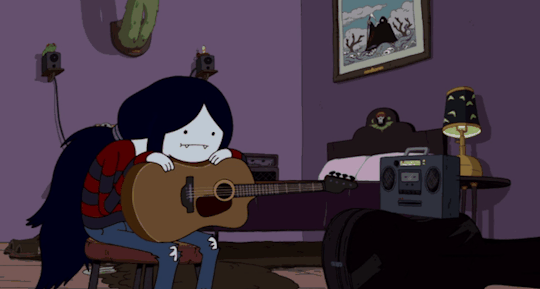
Not the original goth gf, but she is a goth gf. Gay and aesthetics aside, I really liked that the show let her be a bit weird and gross (which she should be considering she's kind of undead) and her tragic backstory gets me every time. The best thing is she's still a big softie, who takes good care of Ice King / Simon when he's around; you don't see that kind of (grand)daughter character in media much.
Beverly Marsh // It (2017)

I haven't read the book but tbh I liked the agency the first movie awarded her enough that I'm afraid of jeopardising it; I don't like how the book portrays / handles her sexuality. She is a survivor of csa, but she's a fighter regardless. I like that about her.
Darlene Alderson // Mr. Robot
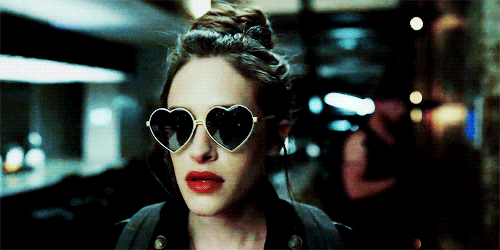
I honestly debated putting her on this list again since I haven't seen a single Mr. Robot episode in so long, but I do remember her character being given her own arc in S2 (and onwards I suppose) and she's a little fucked up in her own way. People look at Rami's character and get sucked in sorting through his alters but Darlene is no less complex - damaged, dangerous, and compelling.
Other honorary mentions:
Riko Sheridan // DCU (an Asian girl who isn't infantilised or reduced to the model minority? shocker!)
Missy // Colette (2018), filmblr (she's actually a real historical figure so I'm not sure if she counts. But she's so radical and ahead of her time - in fact the film seems to suggest she prefers he/him pronouns. I have never seen such intriguing butch representation and I just fell in love with her character. Worth a watch.)
Jo March // Little Women (2019), filmblr (since we're talking about historical women... well, she's a period film character but not a real one, but she's highly evocative of certain female experiences in much the same way)
Blue // The True Lives of the Fabulous Killjoys (so I didn't wanna crowd this list with too many android ladies but she's the first queer android girl character I came across and I loved her instantly. Too bad they buried her gay but her entire concept is my aesthetic)
Rem // Death Note (I feel like I'm obligated to mention DN, too bad it has shitty writing wrt female characters, that's why I have no choice but to stan the lesbian monster gf friend who is so in love with her gal pal she would die for her. Ugh, poetic cinema)
Ok now I am gonna tag @lawliyeeeet @sweetgloss @dressed-to-keehl @3dnygma @hikenacedabi and anyone else who wants to I guess
6 notes
·
View notes
Text
Pluralistic, your daily link-dose: 28 Feb 2020

Today's links
Clearview AI's customer database leaks: Sic semper grifter.
The Internet of Anal Things: Recreating Stelarc's "Amplified Body" with an IoT butt-plug.
Oakland's vintage Space Burger/Giant Burger building needs a home! Adopt a googie today.
Fan-made reproduction of the Tower of Terror: Even has a deepfaked Serling.
Drawing the Simpsons with pure CSS: Impractical, but so impressive.
Let's Encrypt issues its billionth cert: 89% of the web is now encrypted.
AI Dungeon Master: A work in progress, for sure.
How to lie with (coronavirus) maps: Lies, damned lies, and epidemiological data-visualizations.
This day in history: 2019, 2015
Colophon: Recent publications, current writing projects, upcoming appearances, current reading

Clearview AI's customer database leaks (permalink)
Clearview is the grifty facial recognition startup that created a database by scraping social media and now offers cops secretive deals on its semi-magic, never-peer-reviewed technology. The company became notorious in January after the NYT did a deep dive into its secretive deals and its weird, Trump-adjascent ex-male-model founder.
(the Times piece was superbly researched but terribly credulous about Clearview's marketing claims)
https://www.nytimes.com/2020/01/18/technology/clearview-privacy-facial-recognition.html
Yesterday, Clearview warned its customers that it had been hacked and lost its customer database. Today, that customer database was published.
https://www.buzzfeednews.com/article/ryanmac/clearview-ai-fbi-ice-global-law-enforcement
It seems that the NYT weren't the only ones to take Clearview's marketing claims at face value. Its client list includes the DoJ, ICE, Macy's, Walmart, and the NBA. All in all the dump includes more than 2,200 users, including "law enforcement agencies, companies, and individuals around the world."
Included: state AGs, university rent-a-cops, and clients in Saudi Arabia.
"BuzzFeed News authenticated the logs, which list about 2,900 institutions and include details such as the number of log-ins, the number of searches, and the date of the last search."
What does Clearview, a sercurity company, say about this ghastly security breach? "Unfortunately, data breaches are part of life in the 21st century."
Big shrug energy.
"Government agents should not be running our faces against a shadily assembled database of billions of our photos in secret and with no safeguards against abuse," ACLU attorney Nathan Freed Wessler, said to BuzzFeed News.
It is amazing that this needs to be said.
"More than 50 educational institutions across 24 states named in the log. Among them are two high schools."
They are:
Central Montco Technical High School in Pennsylvania
Somerset Berkley Regional High School in Massachusetts
The log also has an entry for Interpol.

The Internet of Anal Things (permalink)
In 1994, the notorious/celebrated electronic artist Stelarc did a performance called "Amplified Body" in which he "controlled robots, cameras and other instruments by tensing and releasing his muscles"
https://web.archive.org/web/20120712181429/https://v2.nl/events/amplified-body
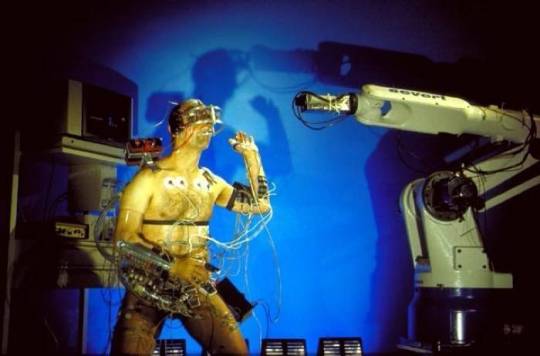
Now, artist/critic Dani Ploeger has revisited Amplified Body with his own performance, which is very similar to Stelarc's, except all the peripherals are controlled by Ploeger tensing and releasing his anal sphincters around a smart butt-plug.
https://www.daniploeger.org/amplified-body
He calls it "B-hind" and it's a ha-ha-only-serious. The buttplug is "an anal electrode with EMG sensor for domestic treatment of faecal incontinence," and the accompanying text is a kind of art-speak parody of IoT biz-speak.
https://we-make-money-not-art.com/b-hind-celebrating-the-internet-of-anal-things
"B-hind offers a unique IoT solution to fully integrate your sphincter muscle in everyday living. The revolutionary anal electrode-powered interface system replaces conventional hand/voice-based interaction, enabling advanced digital control rooted in your body's interior. Celebrating the abject and the grotesque, B‒hind facilitates simple, plug-and-play access to a holistic body experience in the age of networked society."
B-hind was produced in collaboration with V2_, the Lab for the Unstable Media in Rotterdam, and In4Art.

Oakland's vintage Space Burger/Giant Burger building needs a home! (permalink)
Giant Burger was once an East Bay institution, known for its burgers and its gorgeous googie architecture.
https://localwiki.org/oakland/Giant_Burger
One of the very last Giant Burger buildings is now under threat. Though the Telegraph Ave location was rescued in 2015 and converted to a "Space Burger," it's now seeking a new home because it is in the path of the Eastline project.
https://insidescoopsf.sfgate.com/blog/2015/02/24/space-burger-launches-in-uptown-oakland/
The Oakland Heritage Alliance is hoping someone will rescue and move the building: " Do you have an idea for a new location for this mid-century icon? Please contact [email protected] if you know of an appropriate lot, project, or site, preferably downtown."
(Image CC BY-SA, Our Oakland)

Fan-made reproduction of the Tower of Terror (permalink)
Orangele set out to re-create the Walt Disney World Twilight Zone Tower of Terror elevator loading zone in the entry area to their home theater. He's not only done an impressive re-make of the set, but he's also augmented it with FANTASTIC gimmicks.
https://www.hometheaterforum.com/community/threads/the-tower-of-terror-theater.365747/
It's not merely that's he's created a rain, thunder and lightning effect outside the patio doors…
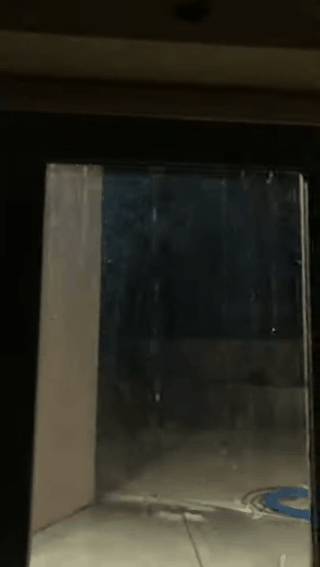
https://www.youtube.com/watch?v=4QMzN0v4mJQ
Nor has he merely created props like this gimmicked side table that flips over at the press of a button.
https://www.youtube.com/watch?v=kY7gQLMnbeA

He's also created HIS OWN ROD SERLING DEEPFAKE.
https://www.youtube.com/watch?time_continue=2&v=MIsjYJwOXSU
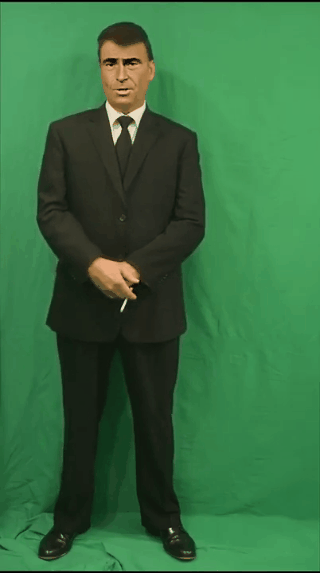
I kinda seriously love that he left Rod's cigarette in. The Disney version looks…uncanny.
Not shown: "exploding fuse box with simulated smoke and fire, motorized lighted elevator dial, motorized/lighted pressure gauge, video monitor playing Tower of Terror ride sequence seen through the elevator door wrap, motorized "elevator door'"
He notes, "I was once married, but now as a single person, I can do whatever I want, haha. NEVER getting married again."
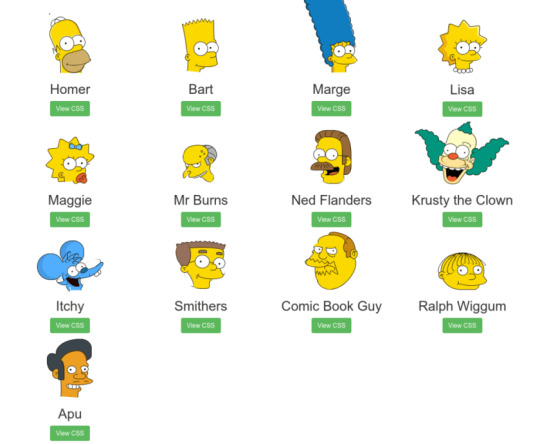
Drawing the Simpsons with pure CSS (permalink)
Implementing animated Simpsons illustrations in CSS isn't the most practical web-coding demo I've seen, but it's among the most impressive. Bravo, Chris Pattle!
(not shown: the eyes animate and blink!)
https://pattle.github.io/simpsons-in-css/
#bart .head .hair1 { top: 22px; left: 0px; width: 6px; height: 7px; -webkit-transform: rotate(-22deg) skew(-7deg, 51deg); -ms-transform: rotate(-22deg) skew(-7deg, 51deg); transform: rotate(-22deg) skew(-7deg, 51deg); }
I especially love the quick-reference buttons to see the raw CSS. It reminds me of nothing so much as the incredibly complex Logo programs I used to write on my Apple ][+ in the 1980s, drawing very complicated, vector-based sprites and glyphs.
https://github.com/pattle/simpsons-in-css/blob/master/css/bart.css
Most interesting is the way that this modular approach to graphics allows for this kind of simple, in-browser transformation.


Let's Encrypt issues its billionth cert (permalink)
When the AT&T whistleblower Mark Klein walked into EFF's offices in 2005 to reveal that his employers had ordered him to help the NSA spy on the entire internet, it was a bombshell.
https://www.eff.org/tags/mark-klein
The Snowden papers revealed the scope of the surveillance in fine and alarming detail. According to his memoir, Snowden was motivated to blow the whistle when he witnessed then-NSA Director James Clapper lie to Senator Ron Wyden about the Klein matter.
Since that day in 2005, privacy advocates have been fretting about just how EASY it was to spy on the whole internet. So much of that was down to the fact that the net wasn't encrypted by default.
This was especially keen for @EFF. After all, we made our bones by suing the NSA in the 90s and winning the right for civilians to access working cryptography (we did it by establishing that "Code is speech" for the purposes of the First Amendment).
https://www.eff.org/deeplinks/2015/04/remembering-case-established-code-speech
Crypto had been legal since 1992, but by Klein's 2005 disclosures, it was still a rarity. 8 years later — at the Snowden moment — the web was STILL mostly plaintext. How could we encrypt the web to save it from mass surveillance?
So in 2014, we joined forces with Mozilla, the University of Michigan and Akamai to create Let's Encrypt, a project to give anyone and everyone free TLS certificates, the key component needed to encrypt the requests your web-server exchanges with your readers.
https://en.wikipedia.org/wiki/Let%27s_Encrypt
Encrypting the web was an uphill climb: by 2017, Let's Encrypt had issued 100m certificates, tipping the web over so that the majority of traffic (58%) was encrypted. Today, Let's Encrypt has issued ONE BILLION certs, and 81% of pageloads use HTTPS (in the USA, it's 91%)! This is astonishing, bordering on miraculous. If this had been the situation back in 2005, there would have been no NSA mass surveillance.
Even more astonishing: there are only 11 full-timers on the Let's Encrypt team, plus a few outside contractors and part-timers. A group of people who could fit in a minibus managed to encrypt virtually the entire internet.
https://letsencrypt.org/2020/02/27/one-billion-certs.html
There are lots of reasons to factor technology (and technologists) in any plan for social change, but this illustrates one of the primary tactical considerations. "Architecture is Politics" (as Mitch Kapor said when he co-founded EFF), and the architectural choices that small groups of skilled people make can reach all the way around the world.
This kind of breathtaking power is what inspires so many people to become technologists: the force-multiplier effect of networked code can imbue your work with global salience (for good or ill). It's why we should be so glad of the burgeoning tech and ethics movement, from Tech Won't Build It to the Googler Uprising. And it's especially why we should be excited about the proliferation of open syllabi for teaching tech and ethics.
https://docs.google.com/spreadsheets/d/1jWIrA8jHz5fYAW4h9CkUD8gKS5V98PDJDymRf8d9vKI/edit#gid=0
It's also the reason I'm so humbled and thrilled when I hear from technologists that their path into the field started with my novel Little Brother, whose message isn't "Tech is terrible," but, "This will all be so great, if we don't screw it up."
https://craphound.com/littlebrother
(and I should probably mention here that the third Little Brother book, Attack Surface, comes out in October and explicitly wrestles with the question of ethics, agency, and allyship in tech).
https://us.macmillan.com/books/9781250757531
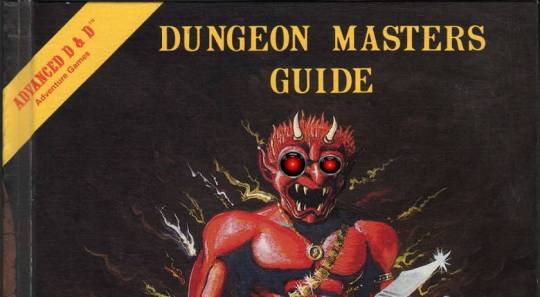
AI Dungeon Master (permalink)
Since 2018, Lara martin has been using machine learning to augment the job of the Dungeon Master, with the goal of someday building a fully autonomous, robotic DM.
https://laramartin.net/
AI Dungeon Master is a blend of ML techniques and "old-fashioned rule-based features" to create a centaur DM that augments a human DM's imagination with the power of ML, natural language processing, and related techniques.
She's co-author of a new paper about the effort, "Story Realization: Expanding Plot Events into Sentences" which "describes a way algorithms to use "events," consisting of a subject, verb, object, and other elements, to make a coherent narrative."
https://aaai.org/Papers/AAAI/2020GB/AAAI-AmmanabroluP.6647.pdf
The system uses training data (plots from Doctor Who, Futurama, and X-Files) to expand text-snippets into plotlines that continue the action. It's a bit of a dancing bear, though, an impressive achievement that's not quite ready for primetime ("We're nowhere close to this being a reality yet").
https://www.wired.com/story/forget-chess-real-challenge-teaching-ai-play-dandd/
This may bring to mind AI Dungeon, the viral GPT-2-generated dungeon crawler from December.
https://aidungeon.io/
As Will Knight writes, "Playing AI Dungeon often feels more like a maddening improv session than a text adventure."
Knight proposes that "AI DM" might be the next big symbolic challenge for machine learning, the 2020s equivalent to "AI Go player" or "AI chess master."

How to lie with (coronavirus) maps (permalink)
The media around the coronavirus outbreak is like a masterclass in the classic "How to Lie With Maps."
https://www.press.uchicago.edu/ucp/books/book/chicago/H/bo27400568.html
Self-described "cartonerd" Kenneth Field's prescriptions for mapmakers wanting to illustrate the spread of coronavirus is a superb read about data visualization, responsibility, and clarity.
https://www.esri.com/arcgis-blog/products/product/mapping/mapping-coronavirus-responsibly/
Both of these images are representing the same data. Look at the map and you might get the impression that coronavirus infections are at high levels across all of China's provinces. Look at the bar-chart and you'll see that it's almost entire Hubei.
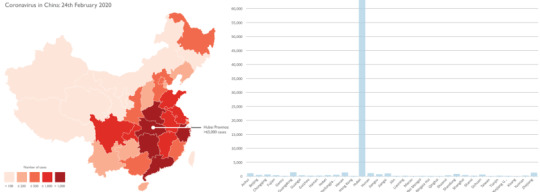
Here's a proposed way to represent the same data on a map without misleading people.

Another point that jumped out: stop coloring maps in red!
"We're mapping a human health tragedy that may get way worse before it subsides. Do we really want the map to be screaming bright red? Red can connotate death, still statistically extremely rare for coronavirus."

This day in history (permalink)
#5yrsago Ad-hoc museums of a failing utopia: photos of Soviet shop-windows https://boingboing.net/2015/02/28/ad-hoc-museums-of-a-failing-ut.html
#5yrsago First-hand reports of torture from Homan Square, Chicago PD's "black site" https://www.theguardian.com/us-news/2015/feb/27/chicago-abusive-confinment-homan-square
#1yrago EFF's roadmap for a 21st Century antitrust doctrine https://www.eff.org/deeplinks/2019/02/antitrust-enforcement-needs-evolve-21st-century
#1yrago Yet another study shows that the most effective "anti-piracy" strategy is good products at a fair price https://www.vice.com/en_us/article/3kg7pv/studies-keep-showing-that-the-best-way-to-stop-piracy-is-to-offer-cheaper-better-alternatives
#1yrago London's awful estate agents are cratering, warning of a "prolonged downturn" in the housing market https://www.bbc.com/news/business-47389160
#1yrago Bad security design made it easy to spy on video from Ring doorbells and insert fake video into their feeds https://web.archive.org/web/20190411195308/https://dojo.bullguard.com/dojo-by-bullguard/blog/ring/
#1yrago Amazon killed Seattle's homelessness-relief tax by threatening not to move into a massive new building, then they canceled the move anyway https://www.seattletimes.com/business/amazon/huge-downtown-seattle-office-space-that-amazon-had-leased-is-reportedly-put-on-market/
#1yrago The "Reputation Management" industry continues to depend on forged legal documents https://www.techdirt.com/articles/20190216/15544941616/pissed-consumer-exposes-new-york-luxury-car-dealers-use-bogus-notarized-letters-to-remove-critical-reviews.shtml

Colophon (permalink)
Today's top sources: Allegra of Oakland Heritage Alliance, Waxy (https://waxy.org/), We Make Money Not Art (https://we-make-money-not-art.com/), Sam Posten (https://twitter.com/Navesink), Slashdot (https://slashdot.org), Kottke (https://kottke.org) and Four Short Links (https://www.oreilly.com/feed/four-short-links).
Hugo nominators! My story "Unauthorized Bread" is eligible in the Novella category and you can read it free on Ars Technica: https://arstechnica.com/gaming/2020/01/unauthorized-bread-a-near-future-tale-of-refugees-and-sinister-iot-appliances/
Upcoming appearances:
Canada Reads Kelowna: March 5, 6PM, Kelowna Library, 1380 Ellis Street, with CBC's Sarah Penton https://www.eventbrite.ca/e/cbc-radio-presents-in-conversation-with-cory-doctorow-tickets-96154415445
Currently writing: I just finished a short story, "The Canadian Miracle," for MIT Tech Review. It's a story set in the world of my next novel, "The Lost Cause," a post-GND novel about truth and reconciliation. I'm getting geared up to start work on the novel now, though the timing is going to depend on another pending commission (I've been solicited by an NGO) to write a short story set in the world's prehistory.
Currently reading: Just started Lauren Beukes's forthcoming Afterland: it's Y the Last Man plus plus, and two chapters in, it's amazeballs. Last week, I finished Andrea Bernstein's "American Oligarchs" this week; it's a magnificent history of the Kushner and Trump families, showing how they cheated, stole and lied their way into power. I'm getting really into Anna Weiner's memoir about tech, "Uncanny Valley." I just loaded Matt Stoller's "Goliath" onto my underwater MP3 player and I'm listening to it as I swim laps.
Latest podcast: Gopher: When Adversarial Interoperability Burrowed Under the Gatekeepers' Fortresses: https://craphound.com/podcast/2020/02/24/gopher-when-adversarial-interoperability-burrowed-under-the-gatekeepers-fortresses/
Upcoming books: "Poesy the Monster Slayer" (Jul 2020), a picture book about monsters, bedtime, gender, and kicking ass. Pre-order here: https://us.macmillan.com/books/9781626723627?utm_source=socialmedia&utm_medium=socialpost&utm_term=na-poesycorypreorder&utm_content=na-preorder-buynow&utm_campaign=9781626723627
(we're having a launch for it in Burbank on July 11 at Dark Delicacies and you can get me AND Poesy to sign it and Dark Del will ship it to the monster kids in your life in time for the release date).
"Attack Surface": The third Little Brother book, Oct 20, 2020.
"Little Brother/Homeland": A reissue omnibus edition with a very special, s00per s33kr1t intro.
7 notes
·
View notes
Link
This.Is.Fucking>Brilliant.
On Sept. 1, with a Category 5 hurricane off the Atlantic coast, an angry wind was issuing from the direction of President Trump’s Twitter account. The apparent emergency: Debra Messing, the co-star of “Will & Grace,” had tweeted that “the public has a right to know” who is attending a Beverly Hills fund-raiser for Mr. Trump’s re-election.
“I have not forgotten that when it was announced that I was going to do The Apprentice, and when it then became a big hit, Helping NBC’s failed lineup greatly, @DebraMessing came up to me at an Upfront & profusely thanked me, even calling me ‘Sir,’ ” wrote the 45th president of the United States.
It was a classic Trumpian ragetweet: aggrieved over a minor slight, possibly prompted by a Fox News segment, unverifiable — he has a long history of questionable tales involving someone calling him “Sir” — and nostalgic for his primetime-TV heyday. (By Thursday he was lashing Ms. Messing again, as Hurricane Dorian was lashing the Carolinas.)
This sort of outburst, almost three years into his presidency, has kept people puzzling over who the “real” Mr. Trump is and how he actually thinks. Should we take him, to quote the famous precept of Trumpology, literally or seriously? Are his attacks impulsive tantrums or strategic distractions from his other woes? Is he playing 3-D chess or Rock ’Em Sock ’Em Robots?
This is a futile effort. Try to understand Donald Trump as a person with psychology and strategy and motivation, and you will inevitably spiral into confusion and covfefe. The key is to remember that Donald Trump is not a person. He’s a TV character.
I mean, O.K., there is an actual person named Donald John Trump, with a human body and a childhood and formative experiences that theoretically a biographer or therapist might usefully delve into someday. (We can only speculate about the latter; Mr. Trump has boasted on Twitter of never having seen a psychiatrist, preferring the therapeutic effects of “hit[ting] ‘sleazebags’ back.”)
But that Donald Trump is of limited significance to America and the world. The “Donald Trump” who got elected president, who has strutted and fretted across the small screen since the 1980s, is a decades-long media performance. To understand him, you need to approach him less like a psychologist and more like a TV critic.
He was born in 1946, at the same time that American broadcast TV was being born. He grew up with it. His father, Fred, had one of the first color TV sets in Jamaica Estates. In “The Art of the Deal” Donald Trump recalls his mother, Mary Anne, spending a day in front of the tube, enraptured by the coronation of Queen Elizabeth in 1953. (“For Christ’s sake, Mary,” he remembers his father saying, “Enough is enough, turn it off. They’re all a bunch of con artists.”)
TV was his soul mate. It was like him. It was packed with the razzle-dazzle and action and violence that captivated him. He dreamed of going to Hollywood, then he shelved those dreams in favor of his father’s business and vowed, according to the book “TrumpNation” by Timothy O’Brien, to “put show business into real estate.”
As TV evolved from the homogeneous three-network mass medium of the mid-20th century to the polarized zillion-channel era of cable-news fisticuffs and reality shocker-tainment, he evolved with it. In the 1980s, he built a media profile as an insouciant, high-living apex predator. In 1990, he described his yacht and gilded buildings to Playboy as “Props for the show … The show is ‘Trump’ and it is sold-out performances everywhere.”
He syndicated that show to Oprah, Letterman, NBC, WrestleMania and Fox News. Everything he achieved, he achieved by using TV as a magnifying glass, to make himself appear bigger than he was.
He was able to do this because he thought like a TV camera. He knew what TV wanted, what stimulated its nerve endings. In his campaign rallies, he would tell The Washington Post, he knew just what to say “to keep the red light on”: that is, the light on a TV camera that showed that it was running, that you mattered. Bomb the [redacted] out of them! I’d like to punch him in the face! The red light radiated its approval. Cable news aired the rallies start to finish. For all practical purposes, he and the camera shared the same brain.
Even when he adopted social media, he used it like TV. First, he used it like a celebrity, to broadcast himself, his first tweet in 2009 promoting a “Late Show With David Letterman” appearance. Then he used it like an instigator, tweeting his birther conspiracies before he would talk about them on Fox News, road-testing his call for a border wall during the cable-news fueled Ebola and border panics of the 2014 midterms.
When he was a candidate, and especially when he was president, his tweets programmed TV and were amplified by it. On CNBC, a “BREAKING NEWS: TRUMP TWEET” graphic would spin out onscreen as soon as the words left his thumbs. He would watch Fox News, or Lou Dobbs, or CNN or “Morning Joe” or “Saturday Night Live” (“I don’t watch”), and get mad, and tweet. Then the tweets would become TV, and he would watch it, and tweet again.
If you want to understand what President Trump will do in any situation, then, it’s more helpful to ask: What would TV do? What does TV want?
It wants conflict. It wants excitement. If there is something that can blow up, it should blow up. It wants a fight. It wants more. It is always eating and never full.
Some presidential figure-outers, trying to understand the celebrity president through a template that they were already familiar with, have compared him with Ronald Reagan: a “master showman” cannily playing a “role.”
The comparison is understandable, but it’s wrong. Presidents Reagan and Trump were both entertainers who applied their acts to politics. But there’s a crucial difference between what “playing a character” means in the movies and what it means on reality TV.
Ronald Reagan was an actor. Actors need to believe deeply in the authenticity and interiority of people besides themselves — so deeply that they can subordinate their personalities to “people” who are merely lines on a script. Acting, Reagan told his biographer Lou Cannon, had taught him “to understand the feelings and motivations of others.”
Being a reality star, on the other hand, as Donald Trump was on “The Apprentice,” is also a kind of performance, but one that’s antithetical to movie acting. Playing a character on reality TV means being yourself, but bigger and louder.
Reality TV, writ broadly, goes back to Allen Funt’s “Candid Camera,” the PBS documentary “An American Family,” and MTV’s “The Real World.” But the first mass-market reality TV star was Richard Hatch, the winner of the first season of “Survivor” — produced by Mark Burnett, the eventual impresario of “The Apprentice”— in the summer of 2000.
Mr. Hatch won that first season in much the way that Mr. Trump would run his 2016 campaign. He realized that the only rules were that there were no rules. He lied and backstabbed and took advantage of loopholes, and he argued — with a telegenic brashness — that this made him smart. This was a crooked game in a crooked world, he argued to a final jury of players he’d betrayed and deceived. But, hey: At least he was open about it!
While shooting that first season, the show’s crew was rooting for Rudy Boesch, a 72-year-old former Navy SEAL and model of hard work and fair play. “The only outcome nobody wanted was Richard Hatch winning,” the host, Jeff Probst, would say later. It “would be a disaster.” After all, decades of TV cop shows had taught executives the iron rule that the viewers needed the good guy to win.
But they didn’t. “Survivor” was addictively entertaining, and audiences loved-to-hate the wryly devious Richard the way they did Tony Soprano and, before him, J.R. Ewing. More than 50 million people watched the first-season finale, and “Survivor” has been on the air nearly two decades.
From Richard Hatch, we got a steady stream of Real Housewives, Kardashians, nasty judges, dating-show contestants who “didn’t come here to make friends” and, of course, Donald Trump.
Reality TV has often gotten a raw deal from critics. (Full disclosure: I still watch “Survivor.”) Its audiences, often dismissed as dupes, are just as capable of watching with a critical eye as the fans of prestige cable dramas. But when you apply its mind-set — the law of the TV jungle — to public life, things get ugly.
In reality TV — at least competition reality shows like “The Apprentice” — you do not attempt to understand other people, except as obstacles or objects. To try to imagine what it is like to be a person other than yourself (what, in ordinary, off-camera life, we call “empathy”) is a liability. It’s a distraction that you have to tune out in order to project your fullest you.
Reality TV instead encourages “getting real.” On MTV’s progressive, diverse “Real World,” the phrase implied that people in the show were more authentic than characters on scripted TV — or even than real people in your own life, who were socially conditioned to “be polite.” But “getting real” would also resonate with a rising conservative notion: that political correctness kept people from saying what was really on their minds.
Being real is not the same thing as being honest. To be real is to be the most entertaining, provocative form of yourself. It is to say what you want, without caring whether your words are kind or responsible — or true — but only whether you want to say them. It is to foreground the parts of your personality (aggression, cockiness, prejudice) that will focus the red light on you, and unleash them like weapons.
Maybe the best definition of being real came from the former “Apprentice” contestant and White House aide Omarosa Manigault Newman in her memoir, “Unhinged.” Mr. Trump, she said, encouraged people in his entourage to “exaggerate the unique part of themselves.” When you’re being real, there is no difference between impulse and strategy, because the “strategy” is to do what feels good.
This is why it misses a key point to ask, as Vanity Fair recently did after Mr. Trump’s assault on Representative Elijah E. Cummings and the city of Baltimore in July, “Is the president a racist, or does he just play one on TV?” In reality TV, if you are a racist — and reality TV has had many racists, like Katie Hopkins, the far-right British “Apprentice” star the president frequently retweets — then you are a racist and you play one on TV.
So if you actually want a glimpse into the mind of Donald J. Trump, don’t look for a White House tell-all or some secret childhood heartbreak. Go to the streaming service Tubi, where his 14 seasons of “The Apprentice” recently became accessible to the public.
You can fast-forward past the team challenges and the stagey visits to Trump-branded properties. They’re useful in their own way, as a picture of how Mr. Burnett buttressed the future president’s Potemkin-zillionaire image. But the unadulterated, 200-proof Donald Trump is found in the boardroom segments, at the end of each episode, in which he “fires” one contestant.
In theory, the boardroom is where the best performers in the week’s challenges are rewarded and the screw-ups punished. In reality, the boardroom is a new game, the real game, a free-for-all in which contestants compete to throw one another under the bus and beg Mr. Trump for mercy.
There is no morality in the boardroom. There is no fair and unfair in the boardroom. There is only the individual, trying to impress Mr. Trump, to flatter Mr. Trump, to commune with his mind and anticipate his whims and fits of pique. Candidates are fired for giving up advantages (stupid), for being too nice to their adversaries (weak), for giving credit to their teammates, for interrupting him. The host’s decisions were often so mercurial, producers have said, that they would have to go back and edit the episodes to impose some appearance of logic on them.
What saves you in the boardroom? Fighting. Boardroom Trump loves to see people fight each other. He perks up at it like a cat hearing a can opener. He loves to watch people scrap for his favor (as they eventually would in his White House). He loves asking contestants to rat out their teammates and watching them squirm with conflict. The unity of the team gives way to disunity, which in the Trumpian worldview is the most productive state of being.
And America loved boardroom Trump — for a while. He delivered his catchphrase in TV cameos and slapped it on a reissue of his 1980s Monopoly knockoff Trump: The Game. (“I’m back and you’re fired!”) But after the first season, the ratings dropped; by season four they were nearly half what they were in season one.
He reacted to his declining numbers by ratcheting up what worked before: becoming a louder, more extreme, more abrasive version of himself. He gets more insulting in the boardroom — “You hang out with losers and you become a loser”— and executes double and quadruple firings.
It’s a pattern that we see as he advances toward his re-election campaign, with an eye not on the Nielsen ratings but on the polls: The only solution for any given problem was a Trumpier Trump.
Did it work for “The Apprentice”? Yes and no. His show hung on to a loyal base through 14 seasons, including the increasingly farcical celebrity version. But it never dominated its competition again, losing out, despite his denials, to the likes of the sitcom “Mike & Molly.”
Donald Trump’s “Apprentice” boardroom closed for business on Feb. 16, 2015, precisely four months before he announced his successful campaign for president. And also, it never closed. It expanded. It broke the fourth wall. We live inside it now.
Now, Mr. Trump re-creates the boardroom’s helter-skelter atmosphere every time he opens his mouth or his Twitter app. In place of the essentially dead White House press briefing, he walks out to the lawn in the morning and reporters gaggle around him like “Apprentice” contestants awaiting the day’s task. He rails and complains and establishes the plot points for that day’s episode: Greenland! Jews! “I am the chosen one!”
Then cable news spends morning to midnight happily masticating the fresh batch of outrages before memory-wiping itself to prepare for tomorrow’s episode. Maybe this sounds like a TV critic’s overextended metaphor, but it’s also the president’s: As The Times has reported, before taking office, he told aides to think of every day as “an episode in a television show in which he vanquishes rivals.”
Mr. Trump has been playing himself instinctually as a character since the 1980s; it’s allowed him to maintain a profile even through bankruptcies and humiliations. But it’s also why, on the rare occasions he’s had to publicly attempt a role contrary to his nature — calling for healing from a script after a mass shooting, for instance — he sounds as stagey and inauthentic as an unrehearsed amateur doing a sitcom cameo.
His character shorthand is “Donald Trump, Fighter Guy Who Wins.” Plop him in front of a camera with an infant orphaned in a mass murder, and he does not have it in his performer’s tool kit to do anything other than smile unnervingly and give a fat thumbs-up.
This is what was lost on commentators who kept hoping wanly that this State of the Union or that tragedy would be the moment he finally became “presidential.” It was lost on journalists who felt obligated to act as though every modulated speech from a teleprompter might, this time, be sincere.
The institution of the office is not changing Donald Trump, because he is already in the sway of another institution. He is governed not by the truisms of past politics but by the imperative of reality TV: never de-escalate and never turn the volume down.
This conveniently echoes the mantra he learned from his early mentor, Roy Cohn: Always attack and never apologize. He serves up one “most shocking episode ever” after another, mining uglier pieces of his core each time: progressing from profanity about Haiti and Africa in private to publicly telling four minority American congresswomen, only one of whom was born outside the United States, to “go back” to the countries they came from.
The taunting. The insults. The dog whistles. The dog bullhorns. The “Lock her up” and “Send her back.” All of it follows reality-TV rules. Every season has to top the last. Every fight is necessary, be it against Ilhan Omar or Debra Messing. Every twist must be more shocking, every conflict more vicious, lest the red light grow bored and wink off. The only difference: Now there’s no Mark Burnett to impose retroactive logic on the chaos, only press secretaries, pundits and Mike Pence.
To ask whether any of this is “instinct” or “strategy” is a parlor game. If you think like a TV camera — if thinking in those reflexive microbursts of adrenaline and testosterone has served you your whole life — then the instinct is the strategy.
And to ask who the “real” Donald Trump is, is to ignore the obvious. You already know who Donald Trump is. All the evidence you need is right there on your screen. He’s half-man, half-TV, with a camera for an eye that is constantly focused on itself. The red light is pulsing, 24/7, and it does not appear to have an off switch.
23 notes
·
View notes
Text
Tagged by: (we all know I mean stolen from: ) @sunszenith
Tagging: All the other thieves.
• NAME: -
• NICKNAME: Winter, Juniper, Glitch, Yuki, Cinders- the nicknames multiply every time I turn around.
• PRONOUNS: He/his & she/hers both ok.
• AGE: mid-20s.
• FAVORITE ANIMAL: I. Love. Birds. Penguinsssss!
• PETS: nuh. took care of my sister’s cat for a long while though.
• HOW LONG HAVE YOU BEEN IN THIS FANDOM?: Mmmm... 2014? 2015?
• TATTOOS / PIERCINGS: Nope! Pain is scary! Scary scary scary!
• STAR SIGN: Aries.
[ ♦ ]
• WHY DID YOU CHOOSE THIS / THESE SPECIFIC CHARACTER(S)?:
I’ll just answer the main three that I stick with here. I always try to go pretty divergent, to both avoid stepping on anyone’s toes and to make sure any duplicates don’t feel like there’s theft or whatever. My interps are mine and it would be strange to see them mirrored anywhere.
So/na: By complete coincidence, the lore rework for Demacia was 2 days after I finished the blog. I... just kind of love music and So/na and so eventually I just decided to give it a shot. I was also mad at a lot of depictions in media, and mad that So/na was just ‘the music girl’, and hyped up on the idea of ‘mage suspicion’ and ‘did she kill her mom’ - and that all cascaded into where we are now. ‘Bad magic with a good mage’ and... well, the rest is history. I also really wanted to write someone who was open with their love, who was a lot more affectionate and less emotionally stunted than a child soldier or a robot girl. Depictions of ‘love’ and ‘care’ in my writing are really important to me. I really just wanted her to be her own person, with agency! And power! And to subvert expectations and not be the ‘tiddy witch’ ( and worse things I heard throughout my league career as a So/na player ). I may not have succeeded in doing her justice, but really... she deserves so much better than what she gets.
Ori: She got entirely abandoned by the lore. At the time I picked her up as my first ever canon muse ( in a decade+ of writing ), I was writing her & Malz. That was after they removed IoW, but before they answered ‘ok what happened’, so I set out on a mission to answer ‘ok what happened’ and did not shy away from the idea that “the timeline itself changed”. My OC before that was a time-and-space hopper so a lot of the themes bled through into all my muses after that. And I really loved how selfless and heroic a person she was. It was really a case of, “Well if no one else cares about her, I will! No matter what!” If So/na is the character that helped me out of some rough times and I feel good thinking about ( I have one of her emotes loaded into my phone so I can look at it and get happy ), Ori is the character that I have a deep affection for. She’s someone I would hug infinitely. At this point it’s probably not wrong to think of her as kind of an OC, but that’s just because I’ve been writing her for 5+ years divergently, thinking and tweaking and retweaking - With that much development, she’s her own strange entity. They kind of all are.
Ire/lia: This was before the rework, ofc, but at the time every single one of her splashes had her frowning except Aviator. And so I went, “oh, she’s happy in this one, that’s so great-” and ran with it. I’ve been running with it ever since. This is really simple but... I just like that she seemed happy. I want her to be happy. It was that simple for me.
1 note
·
View note
Photo

The Coming Age of Imaginative Machines: If you aren't following the rise of synthetic media, the 2020s will hit you like a digital blitzkrieg
The faces on the left were created by a GAN in 2014; on the right are ones made in 2018.
Ian Goodfellow and his colleagues gave the world generative adversarial networks (GANs) five years ago, way back in 2014. They did so with fuzzy and ethereal black & white images of human faces, all generated by computers. This wasn't the start of synthetic media by far, but it did supercharge the field. Ever since, the realm of neural network-powered AI creativity has repeatedly kissed mainstream attention. Yet synthetic media is still largely unknown. Certain memetic-boosted applications such as deepfakes and This Person Does Not Exist notwithstanding, it's safe to assume the average person is unaware that contemporary artificial intelligence is capable of some fleeting level of "imagination."
Media synthesis is an inevitable development in our progress towards artificial general intelligence, the first and truest sign of symbolic understanding in machines (though by far not the thing itself--- rather the organization of proteins and sugars to create the rudimentary structure of what will someday become the cells of AGI). This is due to the rise of artificial neural networks (ANNs). Popular misconceptions presume synthetic media present no new developments we've not had since the 1990s, yet what separates media synthesis from mere manipulation, retouching, and scripts is the modicum of intelligence required to accomplish these tasks. The difference between Photoshop and neural network-based deepfakes is the equivalent to the difference between building a house with power tools and employing a utility robot to use those power tools to build the house for you.
Succinctly, media synthesis is the first tangible sign of automation that most people will experience.
Public perception of synthetic media shall steadily grow and likely degenerate into a nadir of acceptance as more people become aware of the power of these artificial neural networks without being offered realistic debate or solutions as to how to deal with them. They've simply come too quickly for us to prepare for, hence the seemingly hasty reaction of certain groups like OpenAI in regards to releasing new AI models.
Already, we see frightened reactions to the likes of DeepNudes, an app which was made solely to strip women in images down to their bare bodies without their consent. The potential for abuse (especially for pedophilic purposes) is self-evident. We are plunging headlong into a new era so quickly that we are unaware of just what we are getting ourselves into. But just what are we getting into?
Well, I have some thoughts.
I want to start with the field most people are at least somewhat aware of: deepfakes. We all have an idea of what deepfakes can do: the "purest" definition is taking one's face replacing it with another, presumably in a video. The less exact definition is to take some aspect of a person in a video and edit it to be different. There's even deepfakes for audio, such as changing one's voice or putting words in their mouth. Most famously, this was done to Joe Rogan.
I, like most others, first discovered deepfakes in late 2017 around the time I had an "epiphany" on media synthesis as a whole. Just in those two years, the entire field has seen extraordinary progress. I realized then that we were on the cusp of an extreme flourishing of art, except that art would be largely-to-almost entirely machine generated. But along with it would come a flourishing of distrust, fake news, fake reality bubbles, and "ultracultural memes". Ever since, I've felt the need to evangelize media synthesis, whether to tell others of a coming renaissance or to warn them to be wary of what they see.
This is because, over the past two years, I realized that many people's idea of what media synthesis is really stops at deepfakes, or they only view new development through the lens of deepfakes. The reason why I came up with "media" synthesis is because I genuinely couldn't pin down any one creative/data-based field AI wasn't going to affect. It wasn't just faces. It wasn't just bodies. It wasn't just voice. It wasn't just pictures of ethereal swirling dogs. It wasn't just transferring day to night. It wasn't just turning a piano into a harpsichord. It wasn't just generating short stories and fake news. It wasn't just procedurally generated gameplay. It was all of the above and much more. And it's coming so fast that I fear we aren't prepared, both for the tech and the consequences.
Indeed, in many discussions I've seen (and engaged in) since then, there's always several people who have a virulent reaction against the prospect neural networks can do any of this at all, or at least that it'll get better enough to the point it will affect artists, creators, and laborers. Even though we're already seeing the effects in the modeling industry alone.
Look at this gif. Looks like a bunch of models bleeding into and out of each other, right? Actually, no one here is real. They're all neural network-generated people.
Neural networks can generate full human figures, and altering their appearance and clothing is a matter of changing a few parameters or feeding an image into the data set. Changing the clothes of someone in a picture is as easy as clicking on the piece you wish you change and swapping it with any of your choice (or result in the personal wearing no clothes at all). A similar scenario applies for make-up. This is not like an old online dress-up flash game where the models must be meticulously crafted by an art designer or programmer— simply give the ANN something to work with, and it will figure out all the rest. You needn't even show it every angle or every lighting condition, for it will use commonsense to figure these out as well. Such has been possible since at least 2017, though only with recent GPU advancements has it become possible for someone to run such programs in real time.
The unfortunate side effect is that the amateur modeling industry will be vaporized. Extremely little will be left, and the few who do remain are promoted entirely because they are fleshy & real human beings. Professional models will survive for longer, but there will be little new blood joining their ranks. As such, it remains to be seen whether news and blogs speak loudly of the sudden, unexpected automation of what was once seen as a safe and human-centric industry or if this goes ignored and under-reported— after all, the news used to speak of automation in terms of physical, humanoid robots taking the jobs of factory workers, fast-food burger flippers, and truck drivers, occupations that are still in existence en masse due to slower-than-expected roll outs of robotics and a continued lack of general AI.
We needn't have general AI to replace those jobs that can be replicated by disembodied digital agents. And the sudden decline & disappearance of models will be the first widespread sign of this.
Actually, I have an hypothesis for this: media synthesis is one of the first signs that we're making progress towards artificial general intelligence.
Now don't misunderstand me. No neural network that can generate media is AGI or anything close. That's not what I'm saying. I'm saying that what we can see as being media synthesis is evidence that we've put ourselves on the right track. We never should've thought that we could get to AGI without also developing synthetic media technology.
What do you know about imagination?
As recently as five years ago, the concept of "creative machines" was cast off as impossible— or at the very least, improbable for decades. Indeed, the phrase remains an oxymoron in the minds of most. Perhaps they are right. Creativity implies agency and desire to create. All machines today lack their own agency. Yet we bear witness to the rise of computer programs that imagine and "dream" in ways not dissimilar to humankind.
Though lacking agency, this still meets the definition of imagination.
To reduce it to its most fundamental ingredients: Imagination = experience + abstraction + prediction. To get creativity, you need only add "drive". Presuming that we fail to create artificial general intelligence in the next ten years (an easy thing to assume because it's unlikely we will achieve fully generalized AI even in the next thirty), we still possess computers capable of the former three ingredients.
Someone who lives on a flat island and who has never seen a mountain before can learn to picture what one might be by using what they know of rocks and cumulonimbus clouds, making an abstract guess to cross the two, and then predicting what such a "rock cloud" might look like. This is the root of imagination.
As Descartes noted, even the strongest of imagined sensations is duller than the dullest physical one, so this image in the person's head is only clear to them in a fleeting way. Nevertheless, it's still there. Through great artistic skills, the person can learn to express this mental image through artistic means. In all but the most skilled, it will not be a pure 1-to-1 realization due to the fuzziness of our minds, but in the case of expressive art, it doesn't need to be.
Computers lack this fleeting ethereality of imagination completely. Once one creates something, it can give you the uncorrupted output.
Right now, this makes for wonderful tools and apps that many play around with online and on our phones.
But extrapolating this to the near future results in us coming face to face many heavy questions, and not just of the "can't trust what you see variety."
Because think about it.
If I'm a musical artist and I release an album, what if I accidentally recorded a song that's too close to an AI-generated track (all because AI generated literally every combination of notes?) Or, conversely, what if I have to watch as people take my music and alter it? I may feel strongly about it, but yet the music has its notes changed, its lyrics changed, my own voice changed, until it might as well be an entirely different artist making that music. Many won't mind, but many will.
I trust my mother's voice, as many do. So imagine a phisher managing to steal her voice, running it through a speech synthesis network, and then calling me asking me for my social security number. Or maybe I work at a big corporation, and while we're secure, we still recognize each other's voice, only to learn that someone stole millions of dollars from us because they stole the CEO's voice and used to to wire cash to a pirate's account.
Imagine going online and at least 70% of the "people" you encounter are bots. They're extremely coherent, and they have profile images of what looks to be real people. And who knows, you may even forge an e-friendship with some of them because they seem to share your interests. Then it turns out they're just bundles of code.
Oh, and those bot-people are also infesting social media and forums in the millions, creating and destroying trends and memes without much human input. Even if the mainstream news sites don't latch on at first, bot-created and bot-run news sites will happily kick it off for them. The news is supposed to report on major events, global and local. Even if the news is honest and telling the truth, how can they truly verify something like this, especially when it seems to be gaining so much traction and humans inevitably do get involved? Remember "Bowsette" from last year? Imagine if that was actually pushed entirely by bots until humans saw what looked like a happenin' kind of meme and joined in? That could be every year or perhaps even every month in the 2020s onwards.
Likewise, imagine you're listening to a pop song in one country, but then you go to another country and it's the exact same song but most of the lyrics have changed to be more suitable for their culture. That sort of cultural spread could stop... or it could be supercharged if audiences don't take to it and pirate songs/change them and share them at their own leisure.
Or maybe it's a good time to mention how commissioned artists are screwed? Commission work boards are already a race to the bottom— if a job says it pays three cents per word to write an article, you'd better list your going rate as 2 cents per word, and then inevitably the asking rate in general becomes 2 cents per word, and so on and so forth. That whole business might be over within five to ten years if you aren't already extremely established. Because if machines can mimic any art style or writing style (and then exaggerate & alter it to find some better version people like more), you'd have to really be tech-illiterate or very pro-human to want non-machine commissions.
And to go back to deepfakes and deep nudes, imagine the paratypical creep who takes children and puts them into sexual situations, any sexual situation they desire thanks to AI-generated images and video. It doesn't matter who, and it doesn't have to be real children either. It could even be themselves as a child if they still have the reference or use a de-aging algorithm on their face. It's squicky and disgusting to think about, but it's also inevitable and probably has already happened.
And my god, it just keeps going on and on. I can't do this justice, even with 40,000 characters to work with. The future we're about to enter is so wild, so extreme that I almost feel scared for humanity. It's not some far off date in the 22nd century. It's literally going to start happening within the next five years. We're going to see it emerge before our very eyes on this and other subreddits.
I'll end this post with some more examples.
Nvidia's new AI can turn any primitive sketch into a photorealistic masterpiece. You can even play with this yourself here.
Waifu Synthesis- real time generative anime, because obviously.
Few-Shot Adversarial Learning of Realistic Neural Talking Head Models | This GAN can animate any face GIF, supercharging deepfakes & media synthesis
Talk to Transformer | Feed a prompt into GPT-2 and receive some text. As of 9/29/2019, this uses the 774M parameter version of GPT-2, which is still weaker than the 1.5B parameter "full" version."
Text samples generated by Nvidia's Megatron-LM (GPT-2-8.3b). Vastly superior to what you see in Talk to Transformer, even if it had the "full" model.
Facebook's AI can convert one singer's voice into another | The team claims that their model was able to learn to convert between singers from just 5-30 minutes of their singing voices, thanks in part to an innovative training scheme and data augmentation technique. as a prototype for shifting vocalists or vocalist genders or anything of that sort.
TimbreTron for changing instrumentation in music. Here, you can see a neural network shift entire instruments and pitches of those new instruments. It might only be a couple more years until you could run The Beatles' "Here Comes The Sun" through, say, Slayer and get an actual song out of it.
AI generated album covers for when you want to give the result of that change its own album.
Neural Color Transfer Between Images [From 2017], showing how we might alter photographs to create entirely different moods and textures.
Scammer Successfully Deepfaked CEO's Voice To Fool Underling Into Transferring $243,000
"Experts: Spy used AI-generated face to connect with targets" [GAN faces for fake LinkedIn profiles]
This Marketing Blog Does Not Exist | This blog written entirely by AI is fully in the uncanny valley.
Chinese Gaming Giant NetEase Leverages AI to Create 3D Game Characters from Selfies | This method has already been used over one million times by Chinese gamers.
"Deep learning based super resolution, without using a GAN" [perceptual loss-based upscaling with transfer learning & progressive scaling], or in other words, "ENHANCE!"
Expert: AI-generated music is a "total legal clusterf*ck" | I've thought about this. Future music generation means that all IPs are open, any new music can be created from any old band no matter what those estates may want, and AI-generated music exists in a legal tesseract of answerless questions
And there's just a ridiculous amount more.
My subreddit, /r/MediaSynthesis, is filled with these sorts of stories going back to January of 2018. I've definitely heard of people come away in shock, dazed and confused, after reading through it. And no wonder.
6 notes
·
View notes
Text
Which Work Am I A Bigger Fan Of? I Cannot Choose!
I have two works that I really like, and they are Transformers and Sonic The Hedgehog. Both enhanced my creativity, and I grew up with Transformers (the live-action films, anyway; but I got into G1 when I got into the 1980′s); they have extraterrestrials that are allies or enemies with humans (and they have anti-heroes as well (I’m looking at you, Armada Starscream and Shadow The Hedgehog)); and they have English and Japanese versions of their own media (the original Unicron Trilogy and Sonic X are all anime series in which the Japanese versions with English subtitles are better than the English dubs). I have been fans of both works for a couple years (I saw Transformers first, and then Sonic The Hedgehog).
However, I am debating whether I like one more than the other; I believe I am, but I am going to differentiate between these two works to see for myself. Here it goes; I am going to start with Transformers, first.
The first Transformers work I saw was the first live-action film directed by Michael Bay. It looked very realistic, and the graphics were nice. I saw two more live-action films, and they were okay, but the third film went downhill, especially since they killed off some of my favorite characters from there (especially Ironhide; I really liked that black truck, and Sentinel killed him). I don’t remember when I saw the 1986 film, but it is one of these factors that got me into the 1980′s (among The Transformers, in which that animated film was based on). I started to prefer G1 over Bayformers since their styles looked fantastic, and it is also how I got a little into Mecha anime (Golion/Dairugger/Voltron got me even more into Japanese anime).
I then looked to see if there are any other Mecha shows I would watch, and I remembered fans talking about Transformers Armada, and I searched via Anime News Network; when I saw that Ironhide was in there, as well as Starscream, I got the urge to watch it. I saw all 52 episodes of the show (called Micron Legend) with English subtitles, and I was hooked into it. Micron Legend became even more of my favorite Transformers work than even G1 because of many G1 callbacks, certain soundtracks that sounded 1980′s, and many complex characters from both sides. I then saw another show, in which it is called Energon (actually, it was Superlink), and I got as much hooked as I did with the other show, despite some flaws such as not giving certain characters enough screen time. I was upset when the characters from Micron Legend got killed off (especially Ironhide/Demolishor), but was amazed at some new characters, especially those that were based off of their G1 counterparts, such as Inferno, Lazerwave (homage to G1 Shockwave), Wheeljack, Springer, and Omega Supreme. I saw Galaxy Force (original version of Cybertron) once, and lost interest, despite some interesting characters such as Soundwave and Chromia (Thunderblast). Similarly, Headmasters made me lose interest, since some of the characters were really bland, and they were lacking some character development in some of the Transformers (and even humans).
Since the first Bayformers film was the one I liked a lot, I didn’t want to watch anymore live-action films until 2018, in which the Bumblebee film debuted. I was skeptical at first, until I got the chance to saw it; it was fantastic; the film was set in 1987, and it had many themes and styles of the 1980′s, and it stayed true to the G1 continuity (besides Micron Legend, Superlink, and Galaxy Force). And the villains were phenomenal, especially Shatter (ROTF Alice didn’t give me enough excitement for a believably evil Decepticon who is female (or at least feminine), she was too bland, in my opinion). And don’t forget the music, especially when Stan Bush’s song appeared in one scene where Bumblebee was encouraging his human friend, Charlie Watson, to dive off a cliff (which is safe, and has water).
Now let’s go with Sonic The Hedgehog. I have noticed some people playing the games, and I never got the hold of it until I noticed that there was an anime show based on the games (especially the Adventure series), and I decided to give it a watch. The anime was Sonic X, and it was in Japanese with English subtitles. I was blown away because of Sonic’s tendency to break the fourth wall and throw in English here and there, the graphics which looked similar to Micron Legend in many angles, one original character with his many racing supercars (Sam Speed), contains Mecha (usually by Dr. Eggman), the soundtrack, and, of course, Shadow The Hedgehog (the first time I understood that character was in this show). Also, the anime had many callbacks from the previous games (1991-2003; 2003 was when Sonic X was first broadcasted); and the Metarex saga gave me a feel from the part where Unicron debuted in Micron Legend.
One of my cousins have many different Sonic games, since he is a huge fan of them. He had spin-off games as well; one of them was Shadow’s own game. The first time I took interest was when I heard some fans talk about him using guns; at first, I thought it was a joke, until I saw for myself. Many die-hard Sonic fans don’t like the 2005 game, but I certainly liked it, especially after I saw Sonic X; it was dark and edgy, yes, but it also gave the main character more depth and characterization, he can use firearms if he chooses to, and drives vehicles such as motorcycles and cars; I even have the option to play it in English or Japanese (of course with English subtitles for both).
I also did some reviews for three Sonic TV shows during the 1990′s. Adventures Of Sonic The Hedgehog came to mind, especially this one episode, Zoobotnik, in which it featured a villainess, Katella The Huntress, who is the most underrated Sonic character of all time. I found her costume appealing (including the circlet she wears on her forehead), and I found it amusing to see her with Dr. Robotnik/Eggman (I believe this is the only time I will ship Eggman with anyone else; besides Sera/Sara from the OVA, of course). The English shows were not as appealing, but at least I got some insight after watching a few episodes.
I think I like both works because they are related in many ways, even though the Transformers originated in the 1980′s, and Sonic The Hedgehog originated in the 1990′s, among many other differences. I really like extraterrestrial characters, but I also like Mecha robots (especially sentient robots). Maybe I like Transformers even more than Sonic The Hedgehog.
Another thing these two have in common is their voice actors, who appeared in both works; seiyuu are more prominent. Here is a list of English voice actors first, and then I will go with the Japanese voices:
English
- Charlie Adler (Silverbolt in The Transformers (1984-1987), and Starscream in the live-action films (2007-2011); Snively in Sonic SatAM)
- Jim Cummings (Afterburner, Rippersnapper, and a Sharkticon in The Transformers (1984-1987); Dr. Robotnik in Sonic SatAM)
- Frank Welker (Megatron, Soundwave, Skywarp, Rumble, Frenzy, Trailbreaker, Wheelie, many other Decepticons in G1 (Megatron is the most well-known in other works); SWATbots in Sonic SatAM)
- Rob Paulson (Haywire, Air Raid, and Slingshot in The Transformers (1984-1987); Antoine Depardieu in Sonic SatAM)
- Cree Summer (Blackarachnia in Transformers: Animated; Dulcy The Dragon in Sonic SatAM)
- Michael Bell (Swoop, Sideswipe, Bombshell, Brainstorm, First Aid, and Scrapper in The Transformers (1984-1987); Naugus in Sonic SatAM)
- Kath Soucie (Professor Princess, and Trisha in Transformers: Animated; Sally Acorn, and NICOLE in Sonic SatAM)
- Jason Marsden (Cade Burns in Transformers: Rescue Bots; Dirk in Sonic SatAM)
- Gary Chalk (Optimus Prime in Beast Wars and Armada; Grounder in AOSTH, Dr. Robotnik in Sonic Underground)
- Ian James Corlett (Cheetor, Maximal/Sentinel, and Sea Clamp in Beast Wars; Coconuts in AOSTH)
- Scott McNeil (Dinobot, Rattrap, Silverbolt, Dinobot II, Waspinator in Beast Wars, Jetfire and Omega Supreme in the Transformers Unicron Trilogy (2002-2006); MacHopper in AOSTH)
- French Tickner (Bulkhead in Transformers: Energon; Dr. Warpnik, Big Griz, and Professor Von Schlemmer in AOSTH)
- Venus Terzo (Blackarachnia in Beast Wars; Breezie in AOSTH)
- Samuel Vincent (Sideswipe in Transformers: Armada; Sonic’s singing voice in Sonic Underground)
- Kathleen Barr (Botanica in Beast Wars; Momma Robotnik, Katella The Huntress, additional voices in AOSTH)
- Brad Swaile (Kicker Jones in Transformers: Energon; additional voices in AOSTH)
- Matt Hill (Carlos Lopez and Ironhide in the Transformers Unicron Trilogy; Max in Sonic Underground)
- Brian Drummond (Jetstorm in Beast Machines, Blurr in Transformers: Armada, Shockblast in Transformers: Energon, Jetfire in Transformers: Cybertron; Knuckles The Echidna in Sonic Underground)
- Terry Klassen (High Wire, Sixshot, Skyblast, Brimstone, Tim Hanson, and Mr. Stanton in the Transformers Unicron Trilogy (2002-2006); Doctor Brandon Quark, additional voices in AOSTH)
- Maurice LeMarche (Six-Gun in The Transformers (1984-1987); Uncle Chuck, Sleet, Oracle Of Delphius, additional voices in Sonic Underground)
- Tabitha St. Germain (Alexis Thi Dang in Transformers: Armada; Sally Acorn in Sonic Christmas Blast (1996) from AOSTH)
- Cathy Weseluck (Boy at carnival in Transformers: Armada; additional voices in AOSTH and Sonic Underground)
- Lacey Chabert (Dani Burns in Transformers: Rescue Bots; Princess Elise III in Sonic The Hedgehog (2006))
- Roger Craig Smith (Jetstorm, Slipstream, Airazor, Blastwave, and Mayor Mayhem in Transformers: Robots In Disguise (2014-2017); Sonic The Hedgehog in the Sonic games (2010-present) and Sonic Boom)
- Kirk Thornton (Dr. Onishi in Transformers: Robots In Disguise (2001-2002), and Shadelock in Transformers: Robots In Disguise (2014-2017); Shadow The Hedgehog and Orbot in the Sonic games (2010-present) and Sonic Boom))
- Travis Willingham (Sideswipe in War For Cybertron, Fall Of Cybertron and Rise Of The Dark Spot, and Motormaster and Menasor in Transformers: Robots In Disguise (2014-2017); Knuckles The Echidna in the Sonic games (2010-present) and Sonic Boom, Storm The Albatross in Sonic Free Riders (2010), and Zavok in Sonic Lost World (2011))
- Colleen O’Shaughnessey (Jenny in Transformers: Robots In Disguise (2001-2002); Miles “Tails” Prower, Zooey, Chumley, and Belinda in Sonic Boom, and Charmy Bee in the Sonic games (2010-present))
- Michael Yurchak (Zorillor in Transformers: Robots In Disguise (2014-2017); Jet The Hawk in the Sonic games (2010-present))
- Keith Silverstein (Rumble and Frenzy in War For Cybertron, and Blast Off in Fall Of Cybertron and Rise Of The Dark Spark; Vector The Crocodile in the Sonic games (2010-present))
- Troy Baker (Jetfire in War For Cybertron, and Kickback in Fall Of Cybertron and Rise Of The Dark Spark; Espio The Chameleon in the Sonic games (2010-present))
- Wally Wingert (Mirage and Side Burn in Transformers: Robots In Disguise (2001-2002); Cubot in the Sonic games (2010-present) and Sonic Boom))
- Sam Riegel (Starscream in War For Cybertron, Fall Of Cybertron, and Rise Of The Dark Spark, and Snarl in Fall Of Cybertron; Zor in Sonic Lost World)
- Liam O’Brien (Underbite and Kickback in Transformers: Robots In Disguise (2014-2017), and Air Raid and Cyclonus in War For Cybertron; Zazz in Sonic Lost World, and Infinite The Jackal in Sonic Forces)
Japanese
- Kappei Yamaguchi (Rattrap in Beast Wars and Transformers: Animated; Sonic The Hedgehog in AOSTH and SatAM)
- Masashi Ebara (Skywarp, Spike Witwicky, Brawl, Ratchet, Teletraan-I, Steeljaw, Long Haul, Smokescreen, Blitzwing, and many others in G1; Erazor Djinn in Sonic And The Secret Rings)
- Ken Yamaguchi (Blurr in G1, Arblus, Rumble, Slag and Sharkticons in The Transformers: The Movie (1986), Blitzwing, Broadside, Dirge, Silverbolt, Golder, Hot Spot, Cloudracker, Lazerbeak, Ratbat, Superion, Rewind and Slugslinger in Transformers: Headmasters (1987-1988), Hydra and Darkwings in Transformers: Super-God Masterforce (1988-1989); Decoe and Nelson Thorndyke in Sonic X)
- Akimitsu Takase (Blowpipe, Fastlane, Hot Rod, Freeway, and Monzo in The Transformers (Rebirth); the President’s aide in Sonic The Hedgehog (OVA))
- Ken Narita (Caliburst, Cerebros, Stylor, Cloudracker, Triggerhappy, and Sureshot in Transformers: Headmasters (1987-1988); Black Narcissus in Sonic X)
- Banjou Ginga (Ultra Magnus in Transformers: Scramble City (1986) and Transformers: Animated (2007-2009), Scorponok/Mega Zarak in Transformers: Headmasters (1987-1988), Black Zarak in Transformers: Super-God Masterforce (1988-1989), one of the Primes in Transformers: Revenge Of The Fallen (2009); GUN Commander in Shadow The Hedgehog (2005))
- Masaharu Sato (Alpha Trion, First Aid, Bee Drone, Grotusque, Hook, Grimlock, Scourge, Kaen, Punch/Counterpunch, Skydive, Sureshot and Tantrum in Transformers: Headmasters (1987-1988), Gilmer and Leftfoot in Transformers: Super-God Masterforce (1988-1989), Perceptor, Frank, and Mayor Burns in Transformers: Victory (1989); Dr. Eggman in SegaSonic The Hedgehog (1993))
- Hochu Otsuka (Ultra Magnus, Crosshairs, Wingspan, Big Serow, Freeway, Ratbat and Abel in Transformers: Headmasters (1987-1988), Ranger in Transformers: Super-God Masterforce (1988-1989), and Guyhawk in Transformers: Victory (1989); Red Pine in Sonic X)
- Takeshi Kusao (Clouder in Transformers: Super-God Masterforce (1988-1989); Sonic The Hedgehog in Waku Waku Sonic Patrol Car (1991), SegaSonic Cosmo Fighter Galaxy Patrol (1993), and SegaSonic The Hedgehog(1993))
- Hinako Yoshino (Pipo in Transformers: Victory (1989); Ray The Flying Squirrel in SegaSonic The Hedgehog(1993))
- Chafurin (Cicadacon in Beast Wars, General Bryce in Transformers: Prime (2010-2013), Octopunch in Transformers: Robots In Disguise (2014-2017); Old Man Owl in Sonic The Hedgehog (OVA), Zomom in Sonic Lost World)
- Wataru Takagi (Cheetor in Beast Wars, Glenn Whitmann in Transformers (2007), Jetstorm and Safeguard in Transformers: Animated (2007-2009), Jazz in Transformers: Robots In Disguise (2014-2017); Cubot in the Sonic series (2010-present))
- Nobutoshi Canna (Nightscream and Oracle in Beast Machines, Inferno, Lazerwave and Sixshot in Transformers: Superlink, Swindle in Transformers: Animated (2007-2009); Knuckles The Echidna in the Sonic series (1998-present) and Sonic X)
- Mitsuo Iwata (Silverbolt in Beast Wars, Roadbuster in Transformers: Superlink, Wreck-Gar in Transformers: Animated (2007-2009), Hardshell in Transformers: Prime (2010-2013), Blurr in Transformers: Cyberverse (2018-present); Orbot in the Sonic series (2008-present))
- Toru Okawa (Optimus Prime/Convoy and Scourge in Transformers: Micron Legend, Ratchet and Porter C. Powell in Transformers: Animated (2007-2009), Simacore in Transformers: Robots In Disguise (2014-2017); Pachacamac in Sonic Adventure (1998))
- Koji Yusa (Ironhide and Thrust in Transformers: Micron Legend, Ironhide/Irontread and Wing Dagger/Wing Saber in Transformers: Superlink, Prowl in Transformers: Animated (2007-2009); Shadow The Hedgehog)
- Daisuke Kishio (Kicker Jones in Transformers: Superlink, Bumblebee in Transformers: Animated (2007-2009), Quillfire in Transformers: Robots In Disguise (2014-2017); Jet The Hawk in the Sonic games (2005-present))
- Kenta Miyake (Landmine and Omega Supreme in Transformers: Superlink, Bulkhead, Alpha Trion and Blackout in Transformers: Animated (2007-2009), Shockwave in Transformers: Prime (2010-2013), Razorpaw in Transformers: Robots In Disguise (2014-2017); Vector The Crocodile in the Sonic games (2003-present) and Sonic X)
- Katsuyuki Konishi (Optimus Prime/Grand Convoy and Overdrive in Transformers: Superlink, Angry Archer and Spike Witwicky in Transformers: Animated (2007-2009); Lucas in Sonic X)
- Joji Nakata (Megatron in Transformers: Galaxy Force; E-102 Gamma in Sonic Adventure, Zavok in the Sonic games (2013-present), Dark Oak in Sonic X)
- Kotaro Nakamura (Megatron in the Transformers live-action films (2007-2011); Dr. Eggman in the Sonic games (2015-present))
- Kenji Nomura (Jetfire in Transformers: Revenge Of The Fallen (2009), Hardcore Eddie in Transformers: Dark Of The Moon (2011), William Fowler in Transformers: Prime (2010-2013); Storm The Albatross in the Sonic games (2005-present))
- Takashi Nagasako (Issac Sumdac, Snarl and Brawn in Transformers: Animated (2007-2009), Bulkhead in Transformers: Prime (2010-2013); Big The Cat in the Sonic games (2004-present))
- Sanae Kobayashi (Carly Spencer in Transformers: Dark Of The Moon (2011); Chris Thorndyke in Sonic X)
- Yuki Tai (Wheeljack and Makeshift in Transformers: Prime (2010-2013); Zor in Sonic Lost World, Leon in Sonic X)
- Yutaka Aoyama (Dutch in Transformers: Dark Of The Moon (2011), Nightstrike in Transformers: Robots In Disguise (2014-2017); Zazz in Sonic Lost World)
- Ryuzaburo Otomo (Galvatron in Transformers: Age Of Extinction (2014); Black Doom in Shadow The Hedgehog (2005))
- Yutaka Nakano (Harold Attinger in Transformers: Age Of Extinction (2014); the President in Shadow The Hedgehog (2005))
- Aoi Yuki (Windblade in Transformers: Cyberverse, and Shatter in Bumblebee (2018); Sticks The Jungle Badger in Sonic Boom, and the female Avatar in Sonic Forces)
Like I said, Sonic and Transformers have a lot in common, but they are unique in their own ways. Maybe I like Transformers the most because it was from the 1980′s (which, by the way, is my favorite decade). I wasn’t too much of a 1990′s fan, but I did like Sonic, which originated in the 1990′s. So, I suppose Transformers is the winner, and Sonic The Hedgehog is in second place.
Well, that is all I will be saying for now. I will be posting more soon, but I have other things to do, as well. Stay tuned for more posts.
This is FirebirdTransAm68 signing out.
#transformers#sonic the hedgehog#the transformers#sonic#transformer#mobian#1980's#1990's#sonic and transformers have certain voice actors in common#1980's vs. 1990's#english voices are harder to find than Japanese voices... I wonder why...#any other voice actors I missed please list them in your reblogs if you can#first time I recognized some seiyuu was in any transformers media (especially micron legend)#thanks to transformers I got into seiyuu#maybe I just like transformers better
3 notes
·
View notes